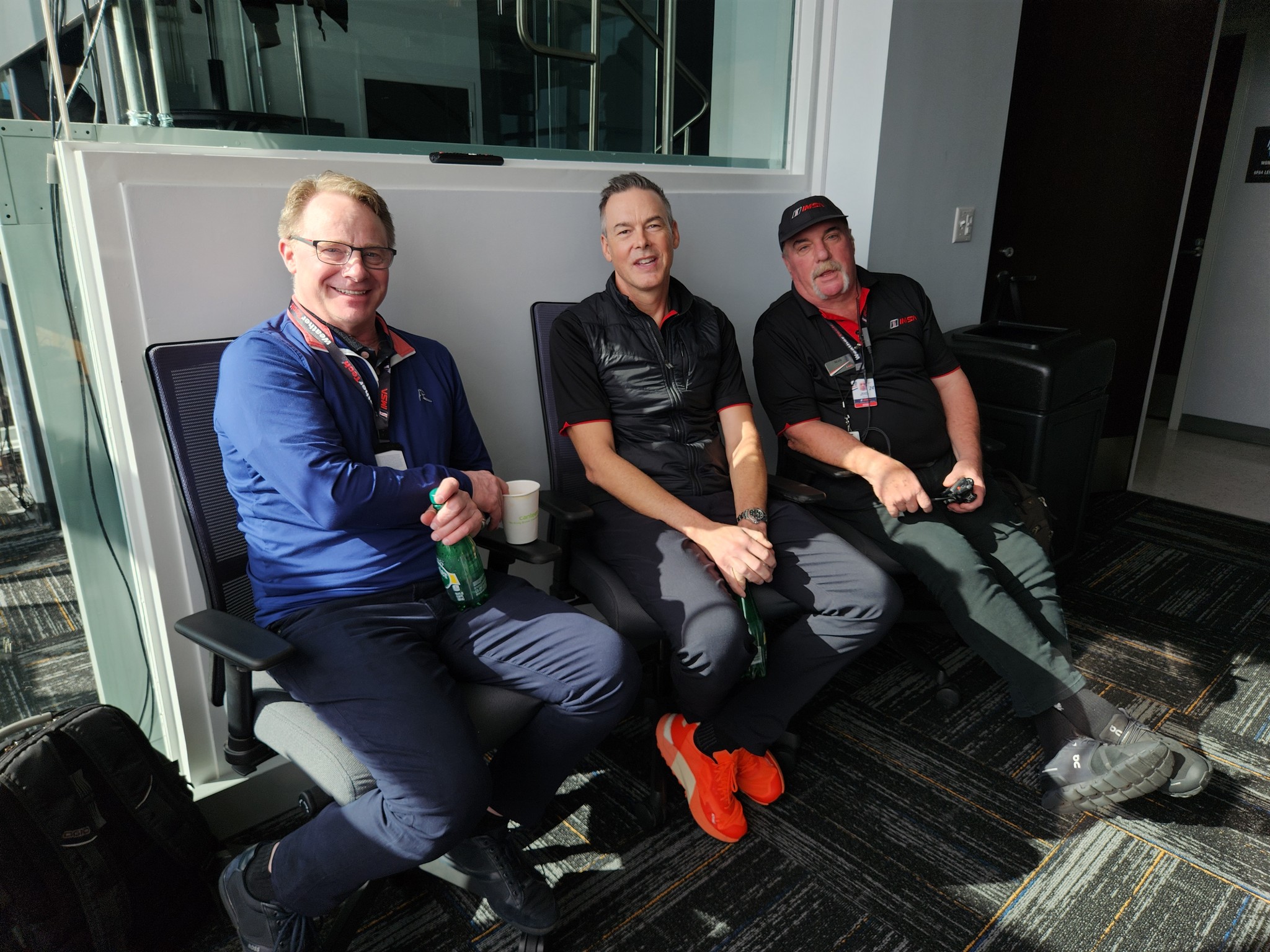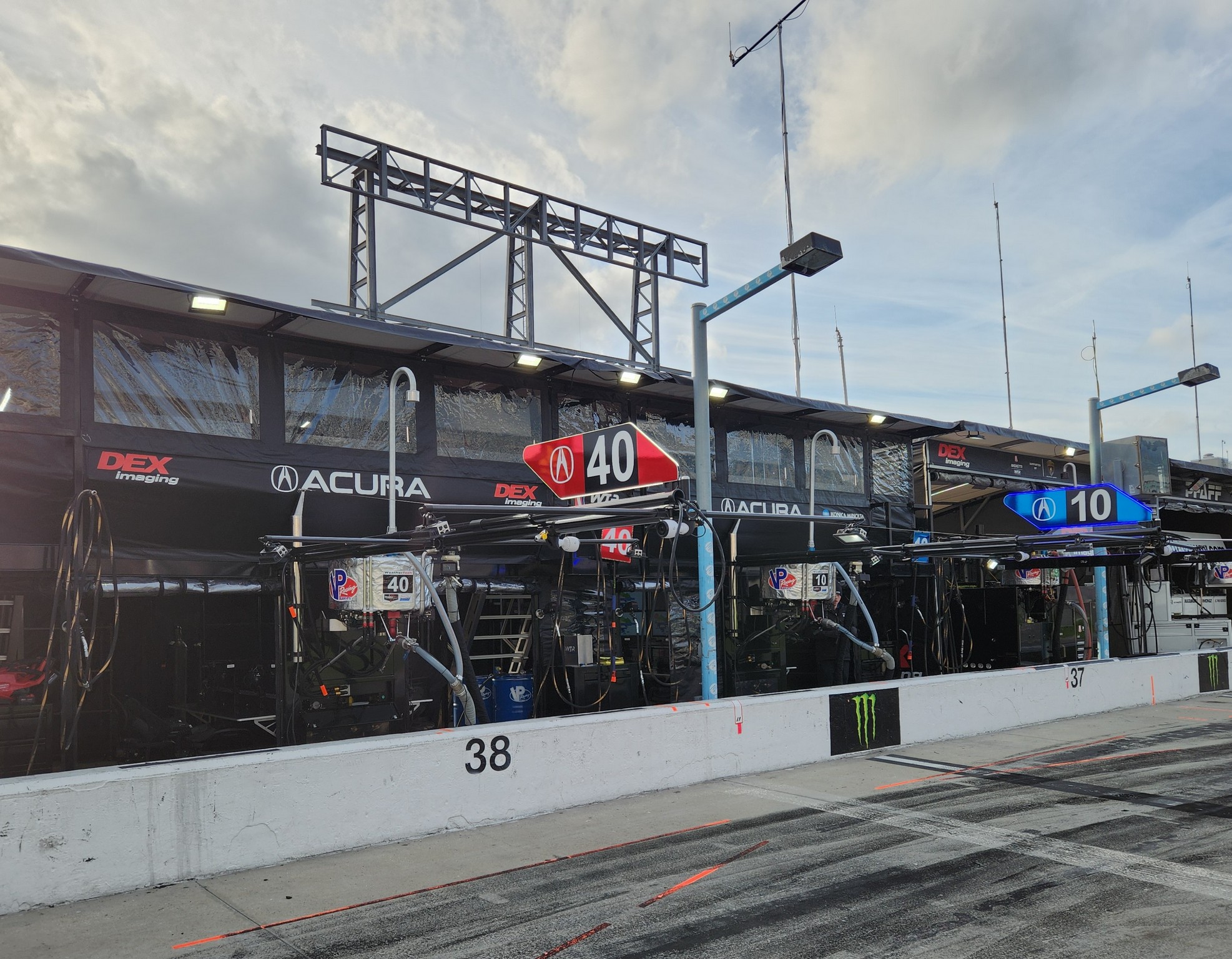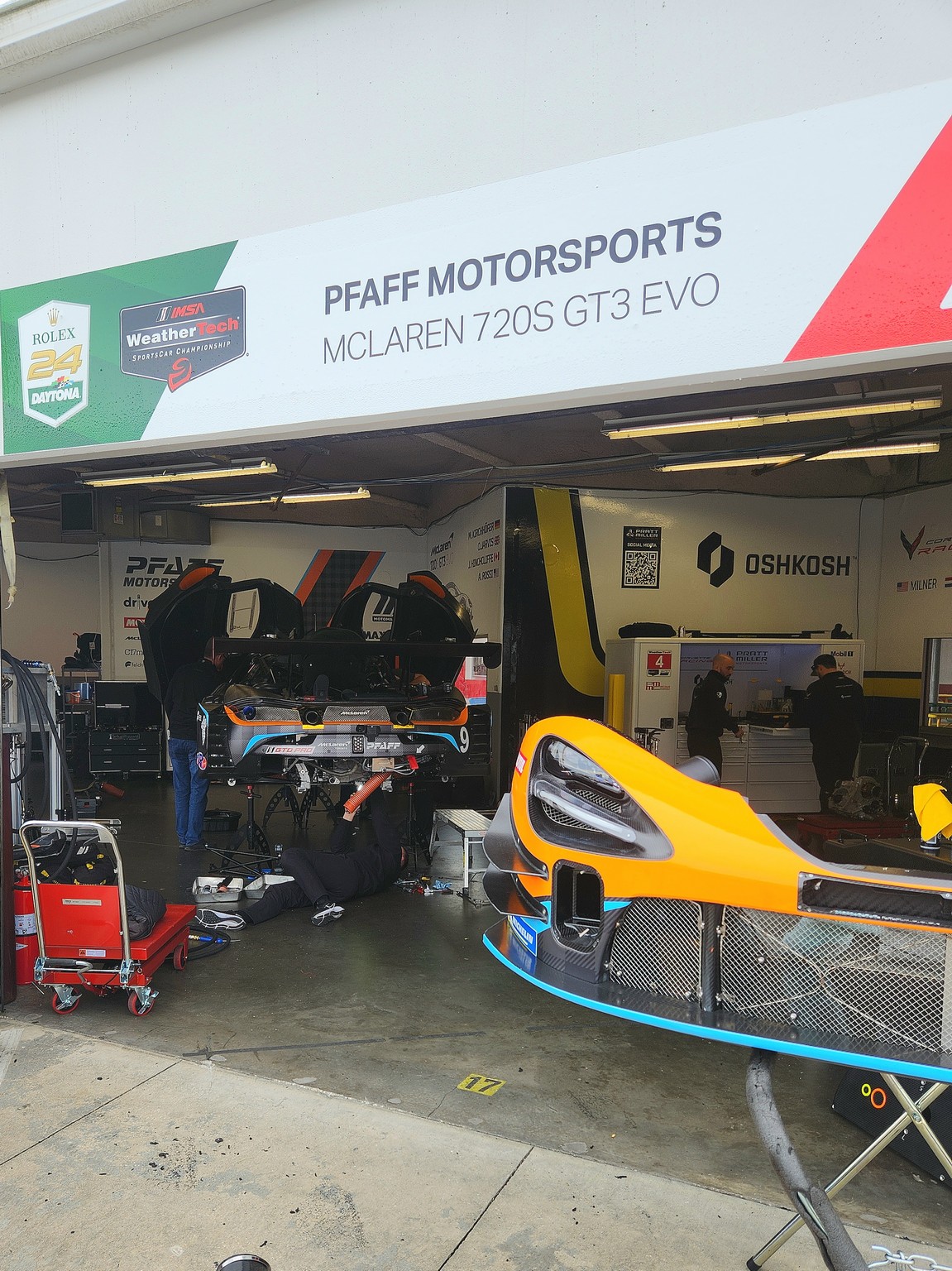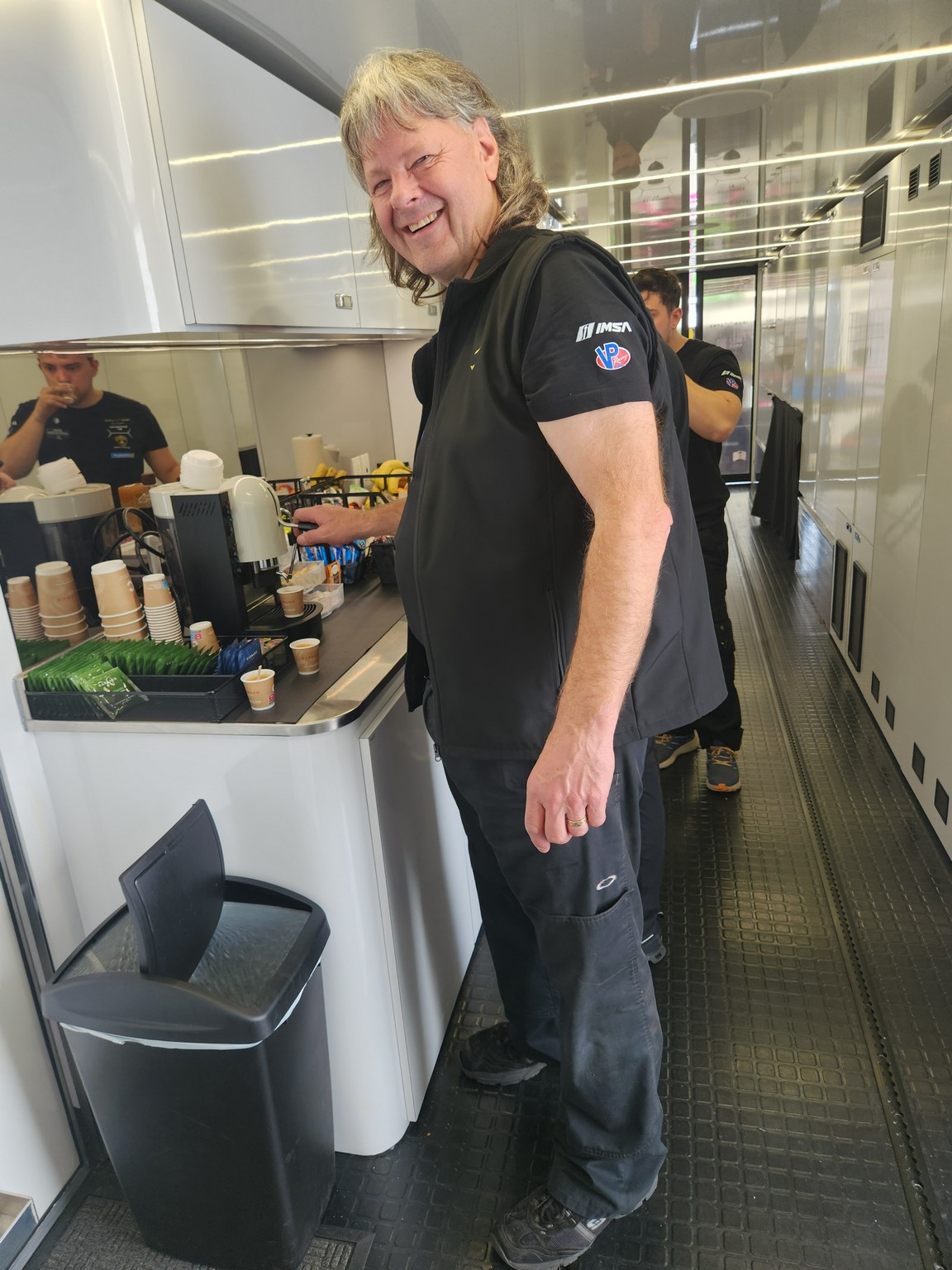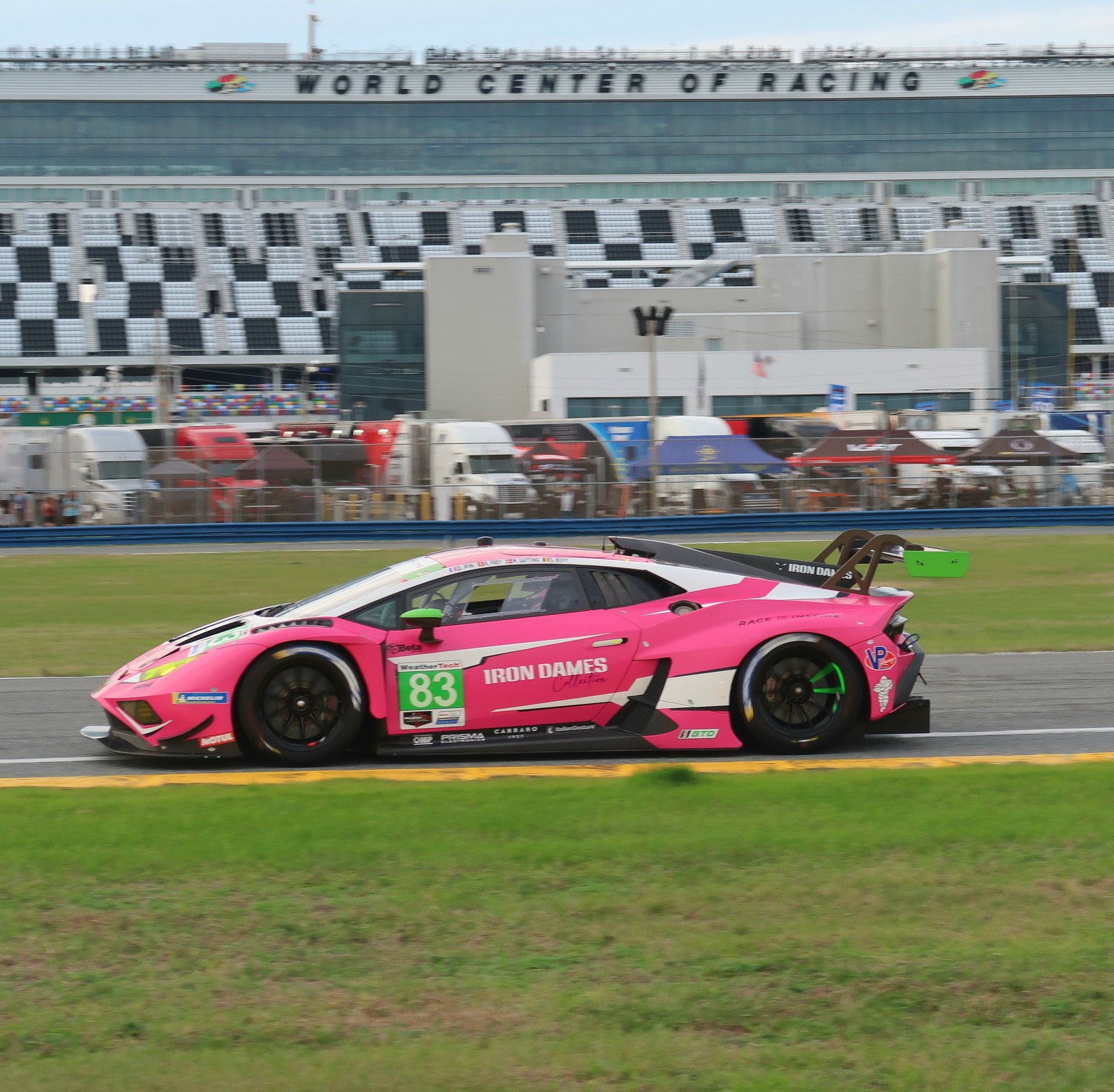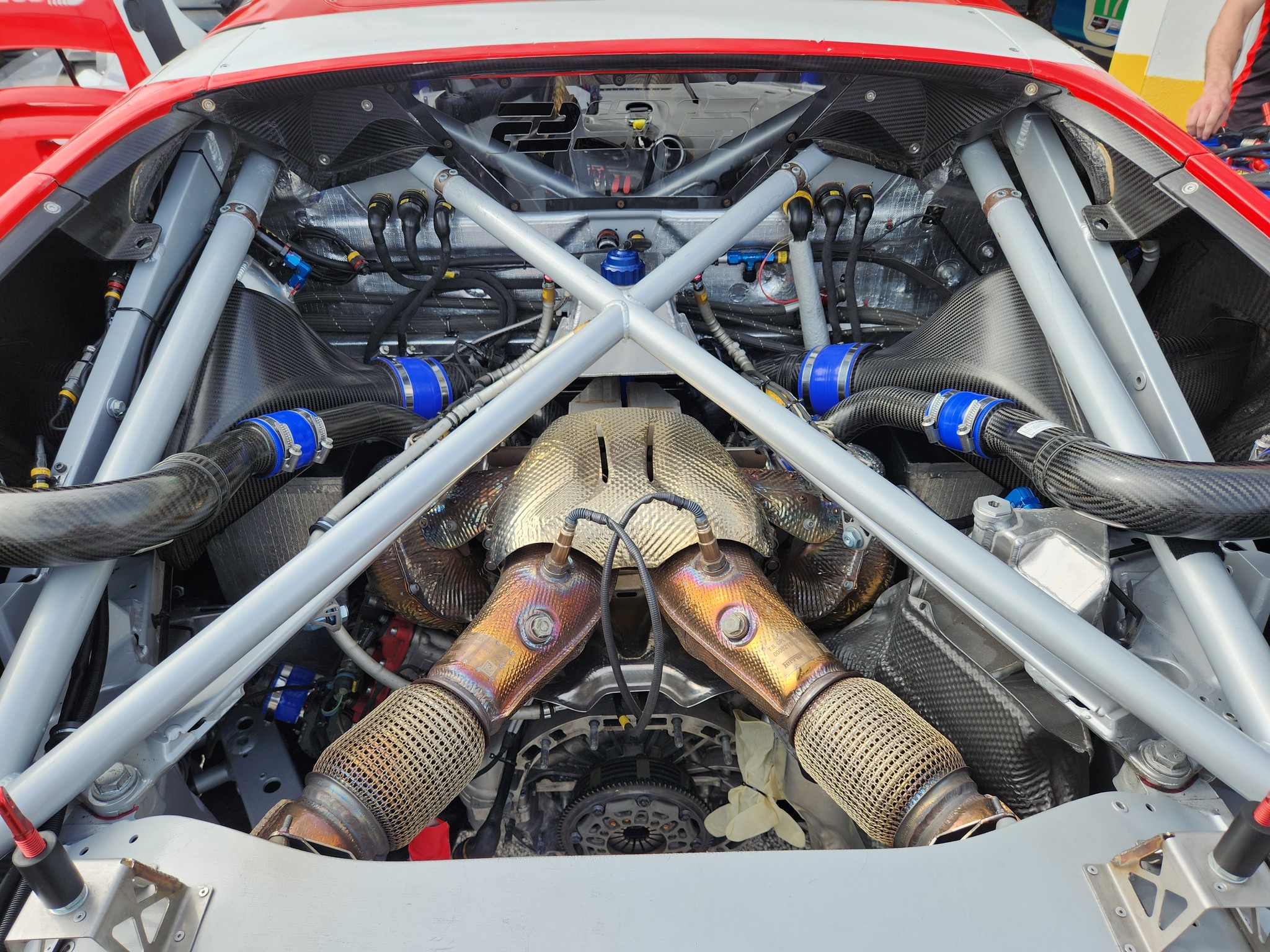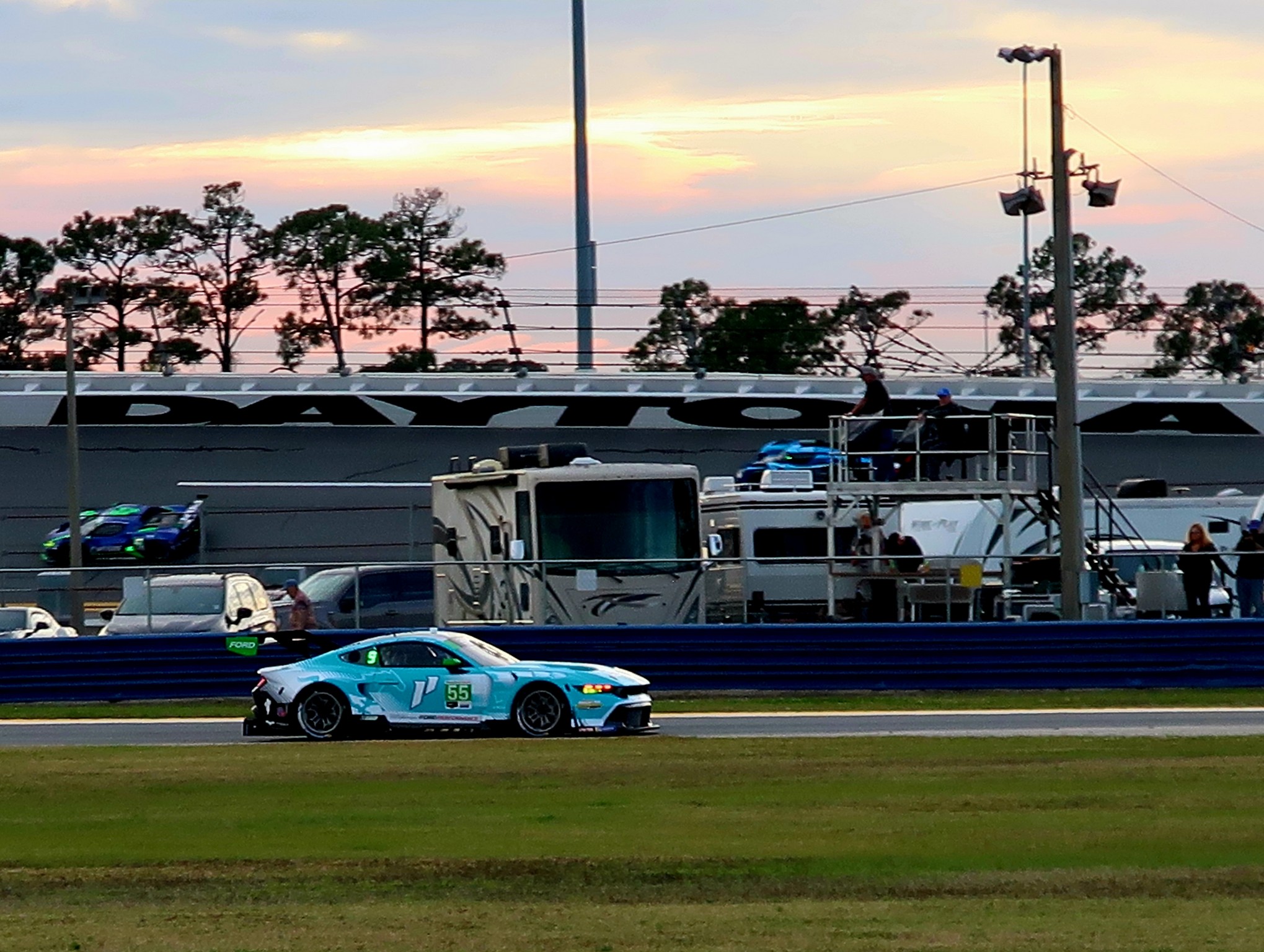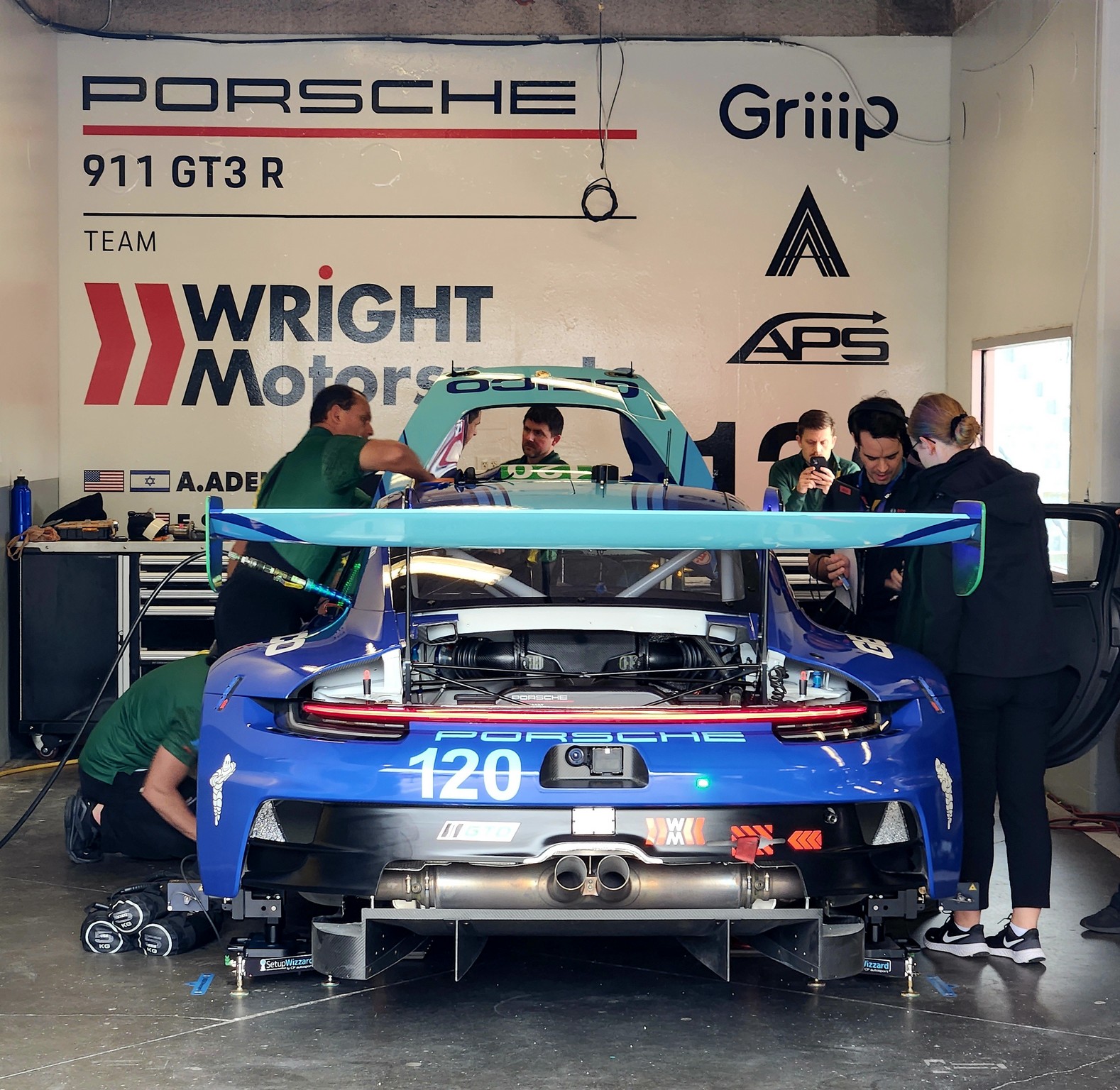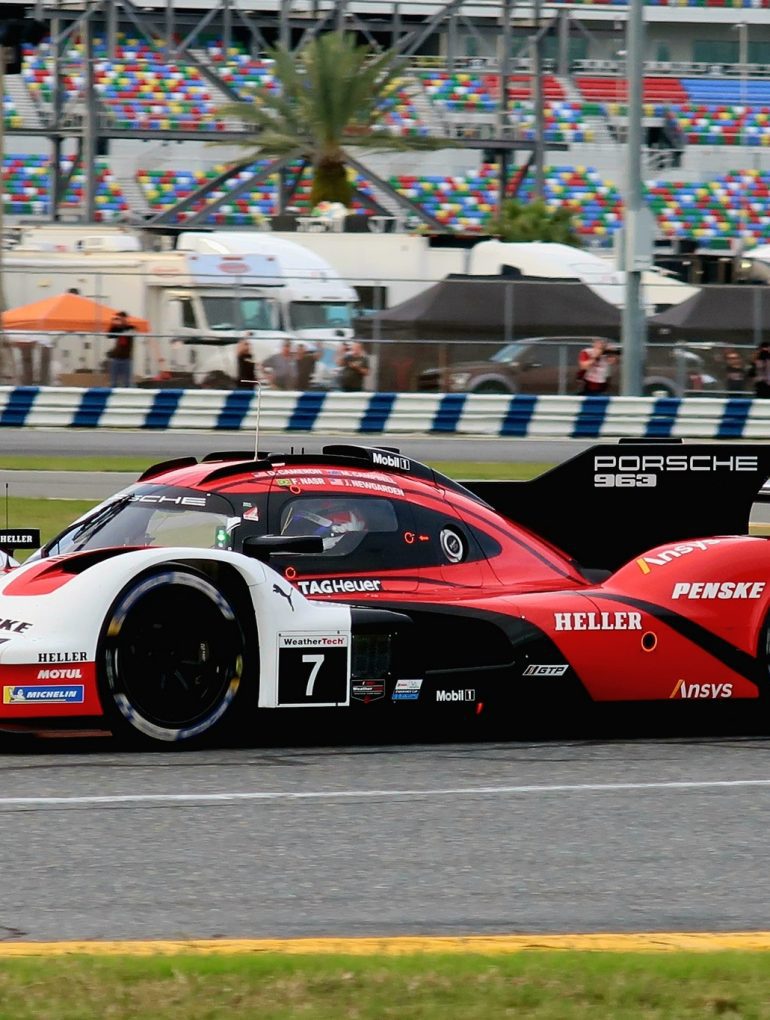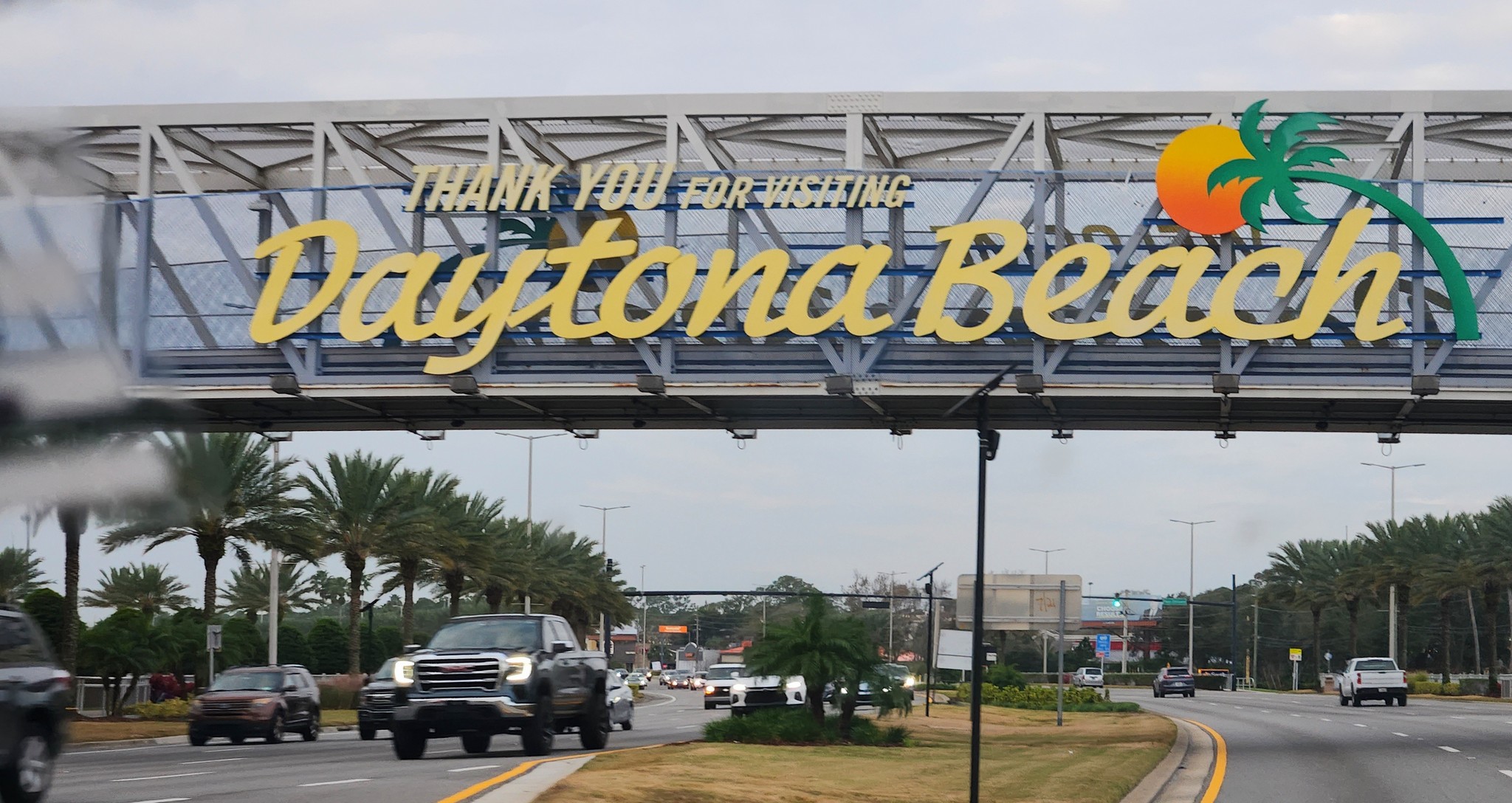The 2024 Daytona 24 promised to be a stellar event. It was once again oversubscribed with entries. Record numbers of Parking passes, tickets and camping spots had been sold by the Daytona International Speedway.
The race would be run on the road course, a 3.56-mile circuit that makes use of most of the NASCAR oval track and banking, with a foray into an infield section starting past the start-finish and rejoining the oval at NASCAR turn one after traversing two horseshoe corners.
Except for the use of a bus-stop chicane (LeMans Chicane) on the back straight starting in 1983, and a shortening of the infield portion, the circuit is unchanged since the race’s inception in 1962. The circuit is tougher than it looks. Traffic is usually heavy, and high-speed banking puts a lot of stress on drivers and equipment.
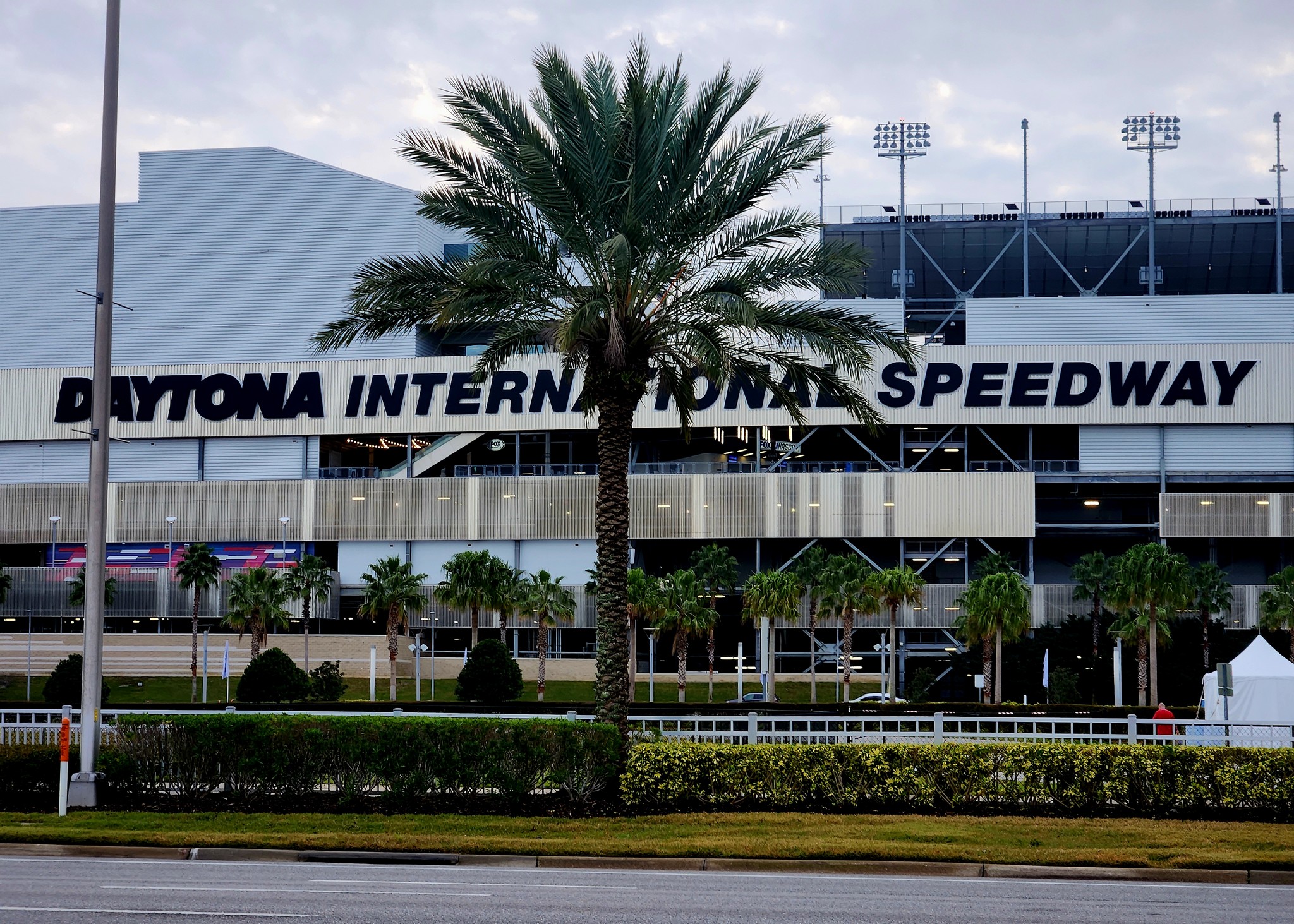
This being the 2nd year of the new GTP Hybrid class, great things were expected after a very good and competitive IMSA season in 2023. The potential was certainly there to deliver.
The final accepted entry was the normal 60 cars (limited due to current pit configurations). However, the 60 came with a twist. One of the cars was a movie car for actor Brad Pitt. He was on hand with a full film crew to film part of the racing movie Apex F1.
The filming started the week prior and continued through the actual race. While the Pitt car did not run the actual 24 hours, his garage mate, an identical John Wright entered Porsche 911 GT3 R did. The installation of movie producer and director Jerry Bruckheimer as Grand Marshall added even more interest for the all-time record crowd.
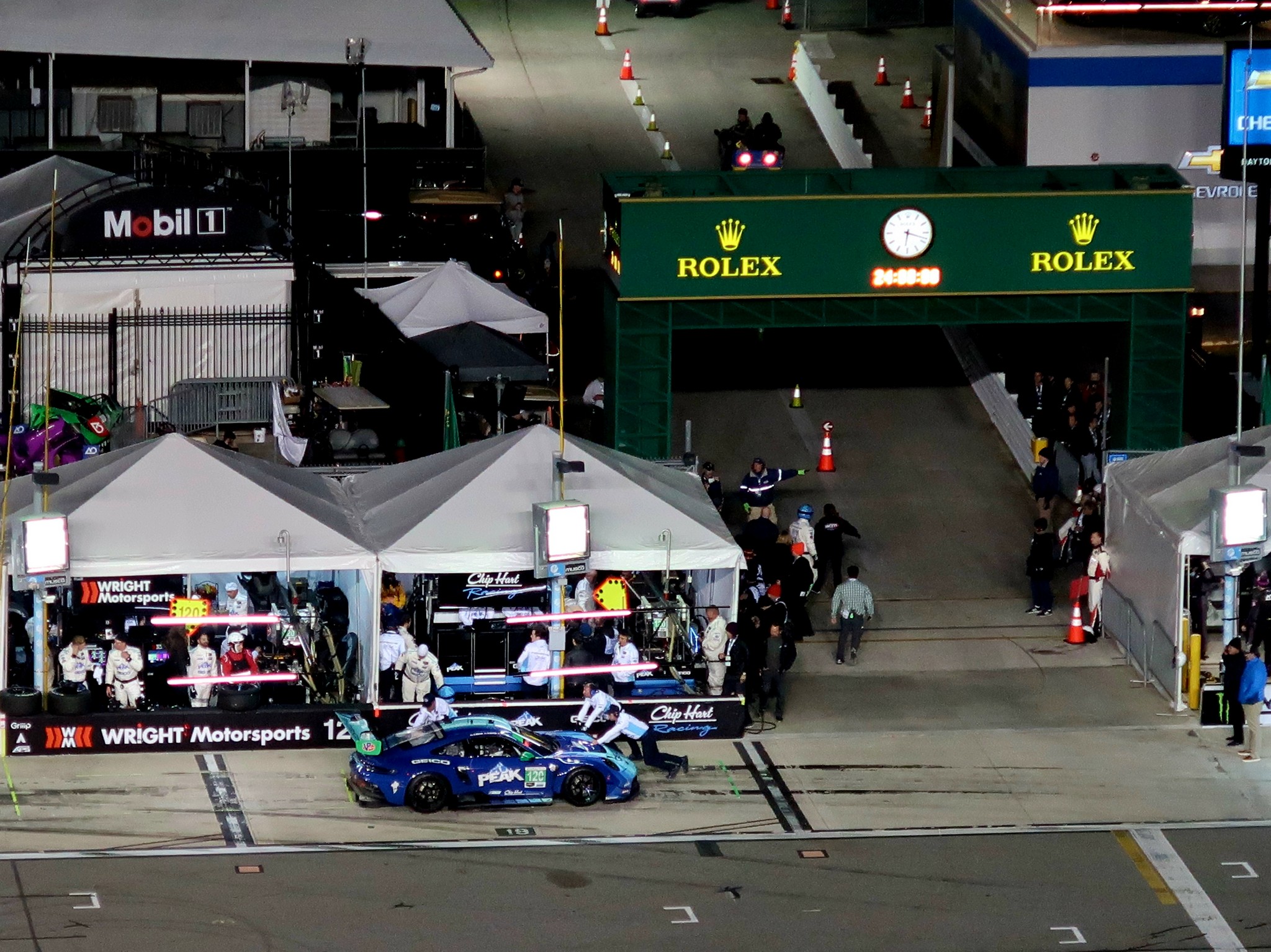
The makeup of the entered cars was as follows:
10 GTP Hybrids consisting of two Cadillacs, two Acuras, two BMWs, and four Porsche 963s. This being the 2nd year of their existence it was expected they would be quicker and more reliable. They were. Notable by their absence was the brand-new Lamborghini GTP car, which although it ran the IMSA test in December at the track (and ran well) it was not entered as the spare car had been crashed and there was a shortage of spare parts deemed necessary to run the 24. This car will enter Sebring.
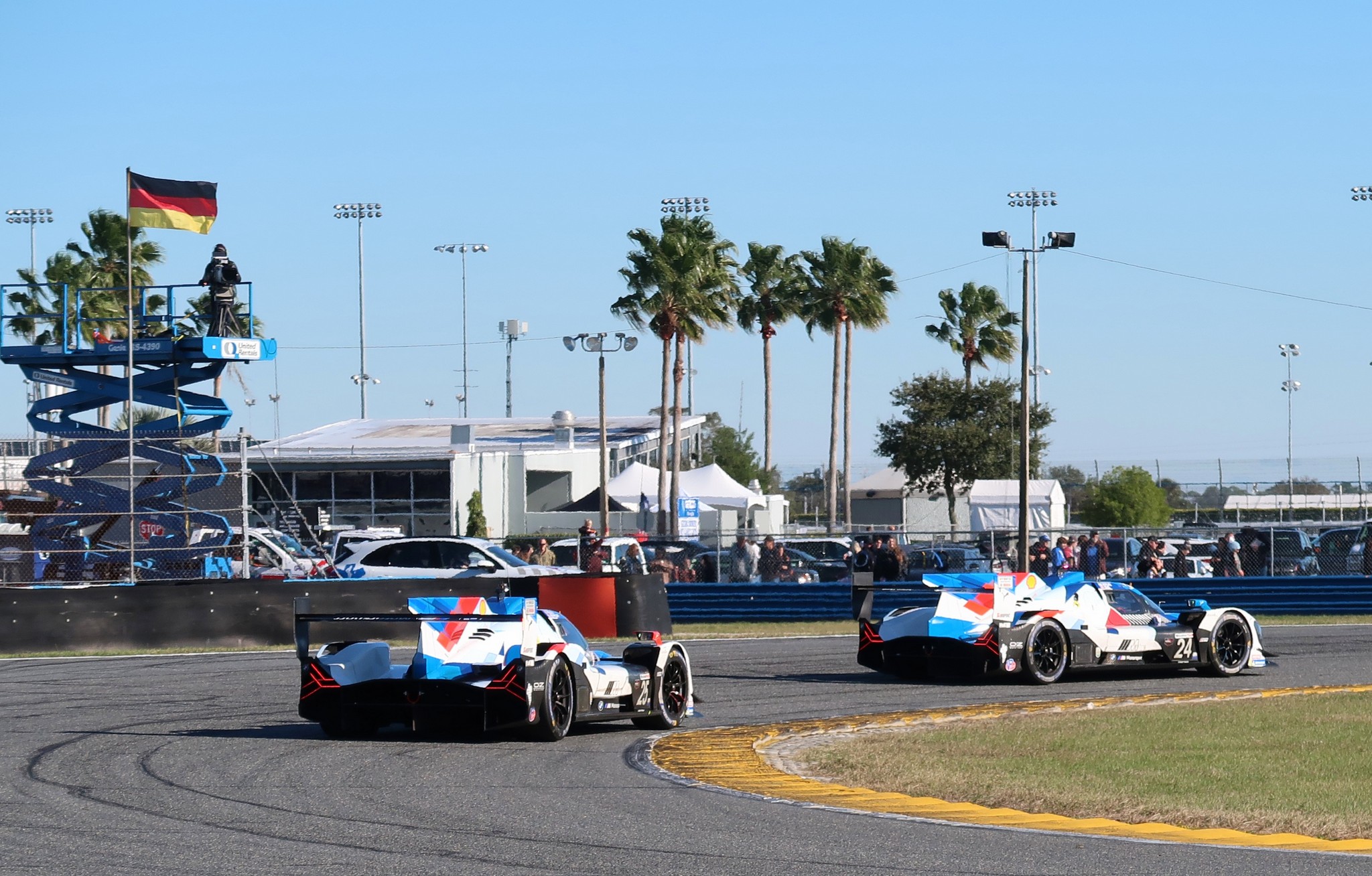
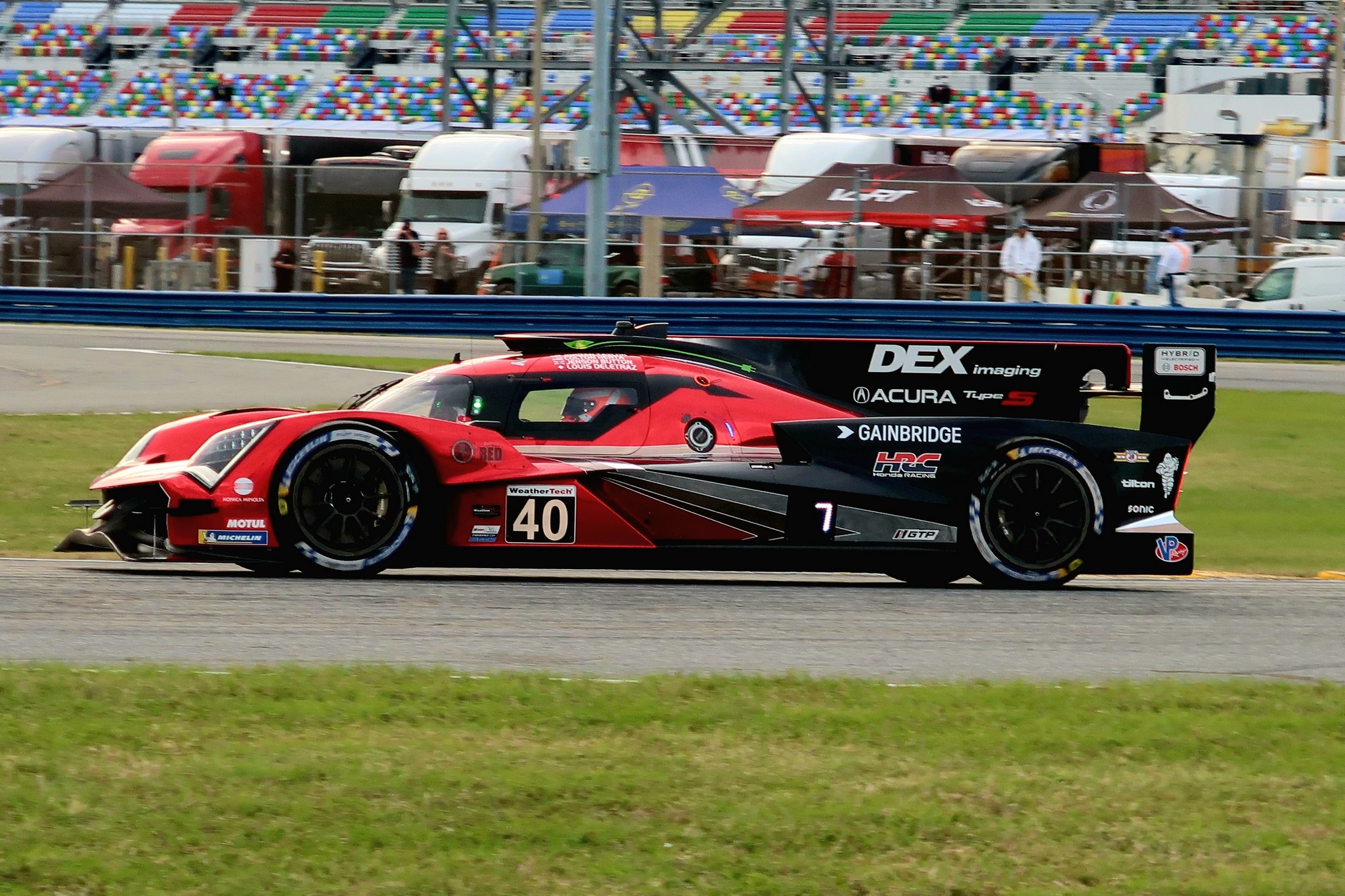
For 2024 the LMP3 class of prototype was dropped from the WeatherTech series and relegated to the VP Challenge support series. This resulted in an entry of 13 LMP2 cars. Several of the former LMP3 teams, notably Riley and Sean Creech stepped up to the LMP2 class. Creech went so far as to enter a Ligier, while the other 12 were all Oreca chassis. As this is a spec class, all teams used the Gibson 4.2-liter V8 engine.
The larger part of the field was the GT3 cars, broken down into two classes called GTP Pro and GTD. The cars in both classes are the same, the only difference being the driver line ups. By rule, GTD had to have at least one Bronze or Silver rated driver, while GTD Pro, anyone could drive regardless of FIA rating. No less than eleven manufacturers were entered in the GT classes: Porsche, Ferrari, Corvette, Ford, BMW, Mercedes, Lamborghini, Acura, Lexus, McLaren and Aston Martin.
Both Corvette and Ford had brand new GT3 cars. The Corvette C8R was now a homologated GT3 car, totally different from the car they ran in 2022 and 2023. No longer a factory effort, it has been entrusted to Pratt & Miller to run the cars, along with customers. Ford had homologated a brand-new Mustang GT3 car. This was a quasi- factory effort entrusted to Multimatic to run. There was also a customer car run by Proton.
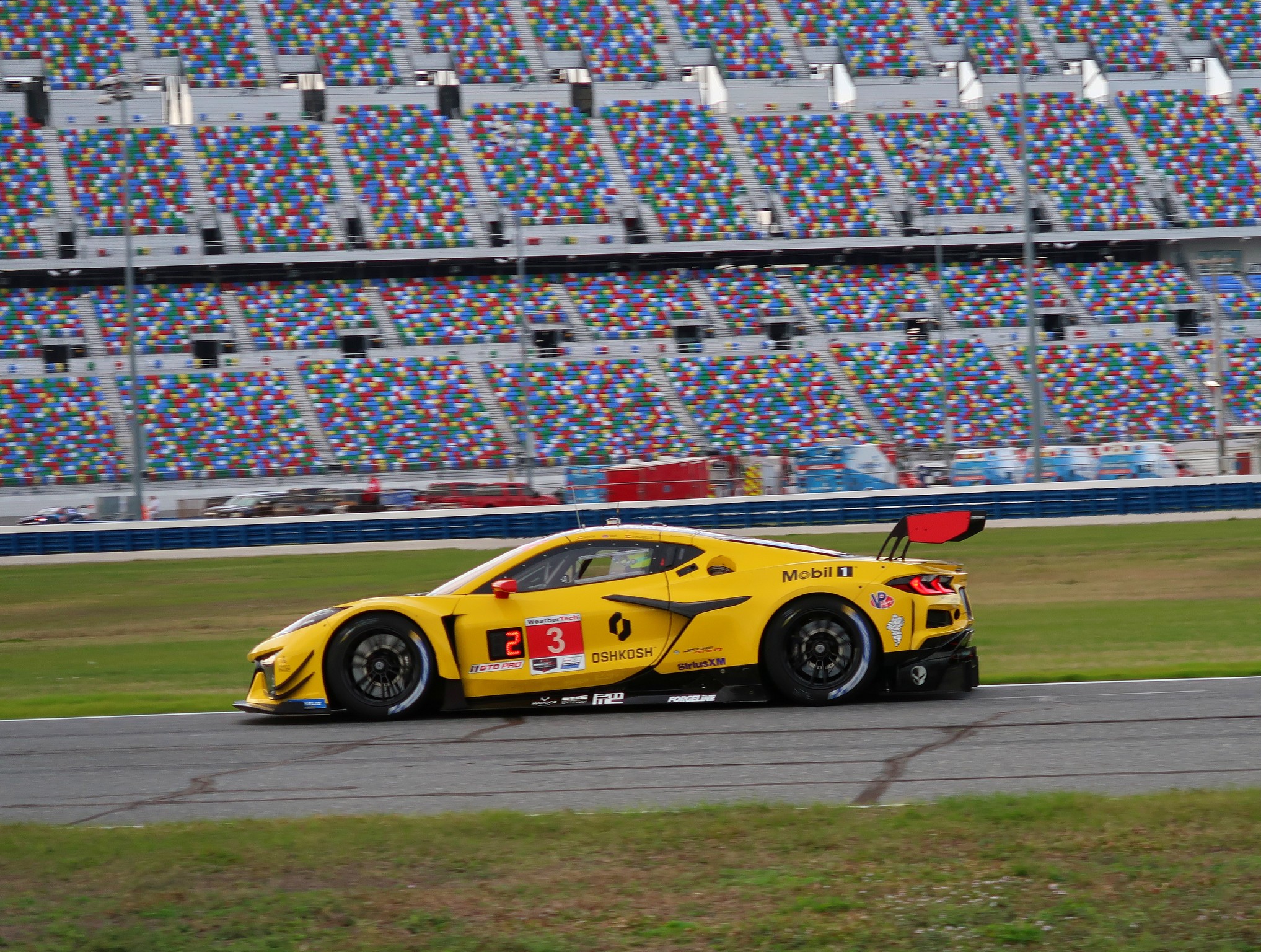
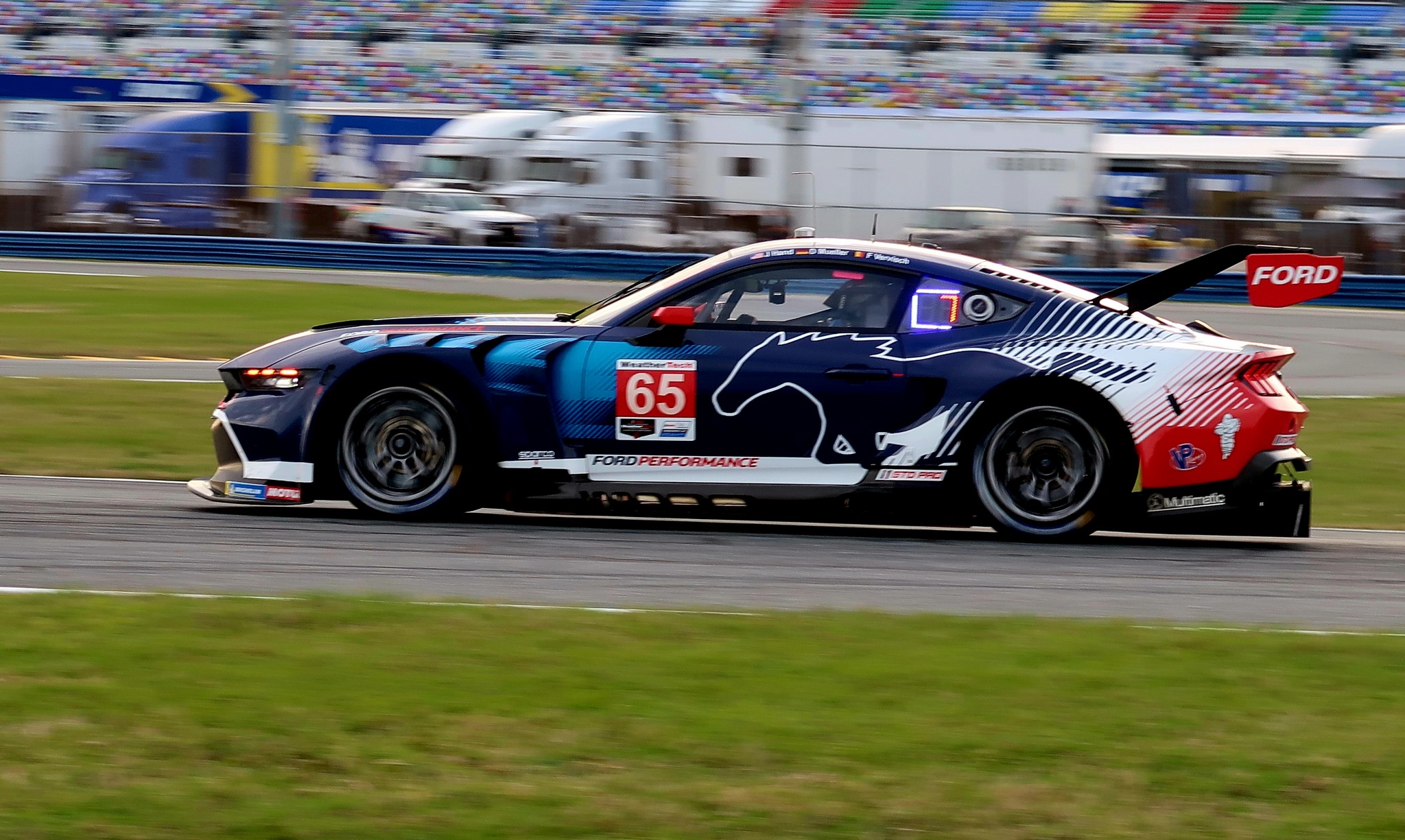
The format of the event for the last several years has been consistent. There is a ROAR event the week before consisting of practice, qualifying, and most notably data collection by IMSA which is then used for any BOP (Balance of Performance) adjustments prior to the race, which is the following week.
The driver lineups were stellar. The field included Indy Car drivers such as Scott Dixon, Colton Herta, Scott McLaughlin, Alex Palou, Marcus Ericsson, James Hinchcliff and others. Ex F1 drivers such as Felipe Massa, Roman Grosjean and Jensen Button were also entered. Some Nascar drivers, including Bubba Wallace were entered in the Michelin Pilot support race for GT4 and TCR cars, ostensibly to get more road course experience.
Ben Keating would once again try for two Rolexes, entering in both a GTP Porsche and an LMP2 car.
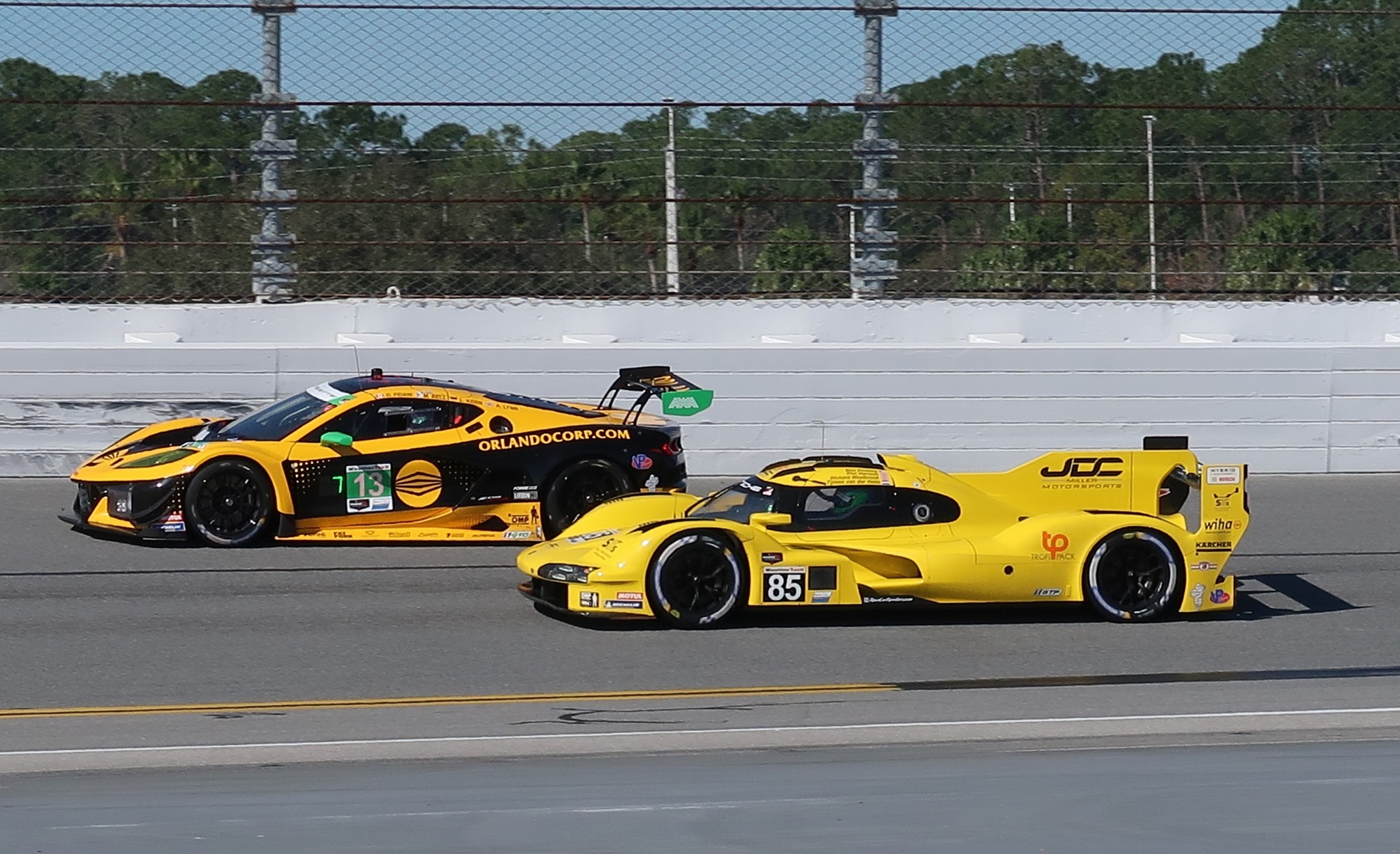
The “Roar”
After a day of press meetings, photo shoots, and countless interviews, the Roar got underway on the Friday before the race week. The big concern among the teams were tires. All cars in IMSA WeatherTech run on Michelin tires. The GTP teams use a special tire made partly from “sustainable materials”, and have two compounds, a soft and a harder one. The LMP2 and GTD classes use a more standard tire and only one compound is available. There are also limits for the race on total sets of tires the team could use:
- GTP – 21 sets (9 soft, 12 medium/hard)
- LMP2 – 23 sets
- GTD/PRO – 31 sets
Given that GTP cars run about 40-50 minutes on a Fuel load (energy load), it was obvious that the tires would have to be double stinted (running one set of tires through two fuel loads as opposed to changing every pit stop) to make the race on 21 sets. To further complicate matters, the soft tires could only be run at night. As of 8 am Sunday of the race, you had to take them off. The big question mark was: how bad would the tire degradation (commonly known as “deg”) be, by the time you got to the end of the second fuel stint.
The other big question was the weather. The first day of the ROAR was 70 degrees and pleasant. The Saturday and Sunday (Qualifying day) was only 50 and windy. So, the car would work quite differently depending on temperature.
Most spent the first days getting a handle on tire wear. The smart ones ran long runs to get a feel for the drop off (in lap time) as the tires wore. The Cadillacs tended to lead the way most of the time. In the GT classes at one point 30 cars were within 1.5 seconds of lap time. Of course, there was constant claims of sandbagging (running purposely slower than the car is capable of) to impact BOP changes. i.e. don’t show your hand prior to the race.
Given the GT3 rule set in place, the Sanctioning bodies (IMSA, WEC) do not like this, and have various tricks to monitor and determine what is happening. IMSA is also looking for a set gap in lap times between the GTP, LMP2 and GTD cars, to facilitate the show.
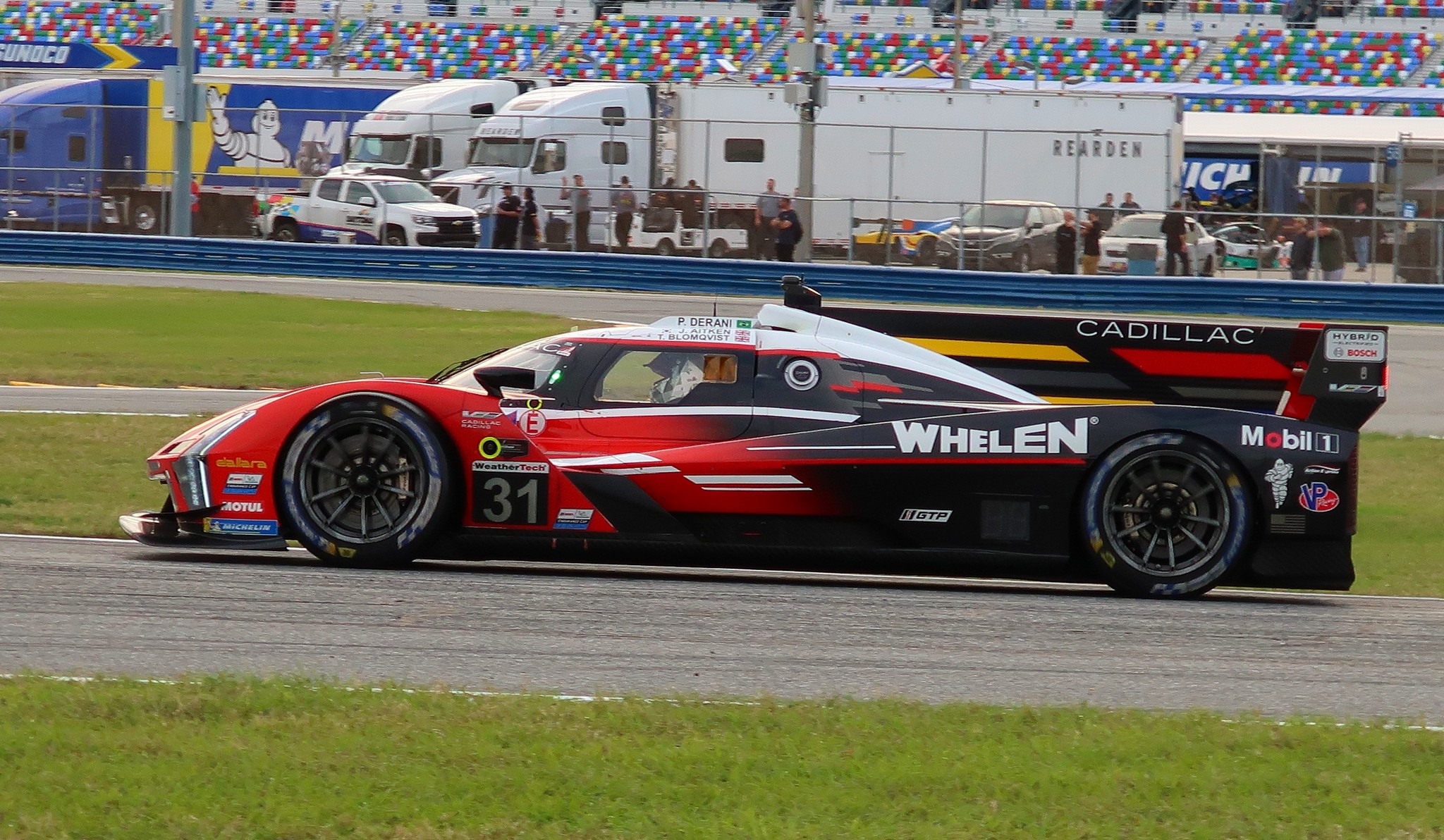
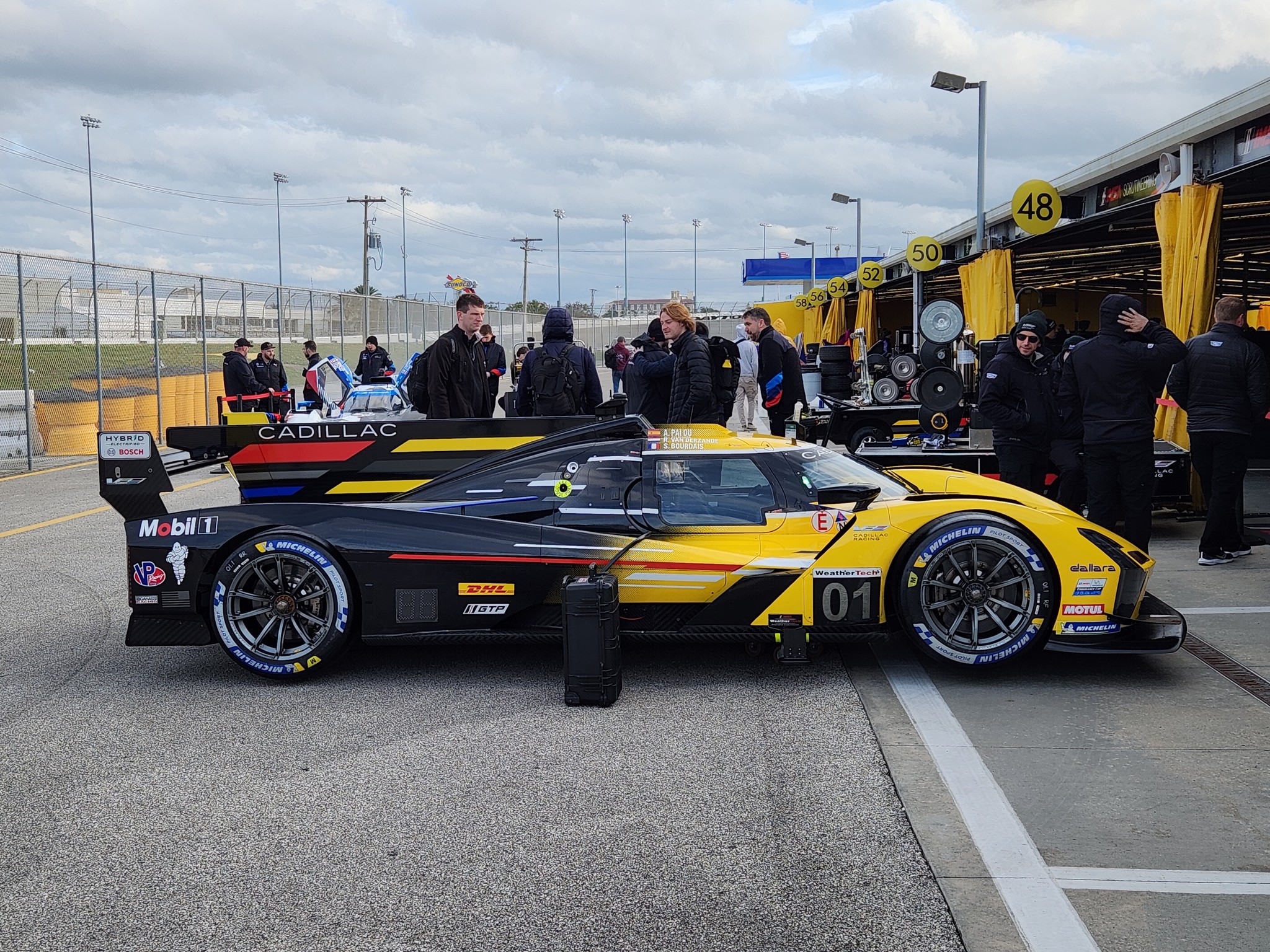
Qualifying day (Sunday) dawned sunny, but very cold and windy. The daytime temperature barely reached 50 and there was a 20 mph east to west wind. This resulted in record qualifying times in all the classes on Sunday afternoon. Amazingly all 10 of the GTP cars broke the existing track record with Pipo Derani taking pole at 1:32.6. Ben Keating to pole in LMP2 at 1:38.5, and the AO racing Porsche driven by Seb Prialux was the fastest GTD car at 1:44.3 .
Since Pfaff Racing has moved to McLaren for 2024, the AO squad is now the designated “factory team”. Most all cars went significantly quicker than they had gone during all the practices, helped no doubt by the cool temperatures and the high tail winds thru the tri oval part of the track. The times were somewhat meaningless as the forecast for the race was in the 70s and humid.
One also did not know what times could be maintained over the course of one or two fuel stints. Outright speed in the race does not really matter, what probably matters more is total time spent to do one, or two stints on one set of tires.
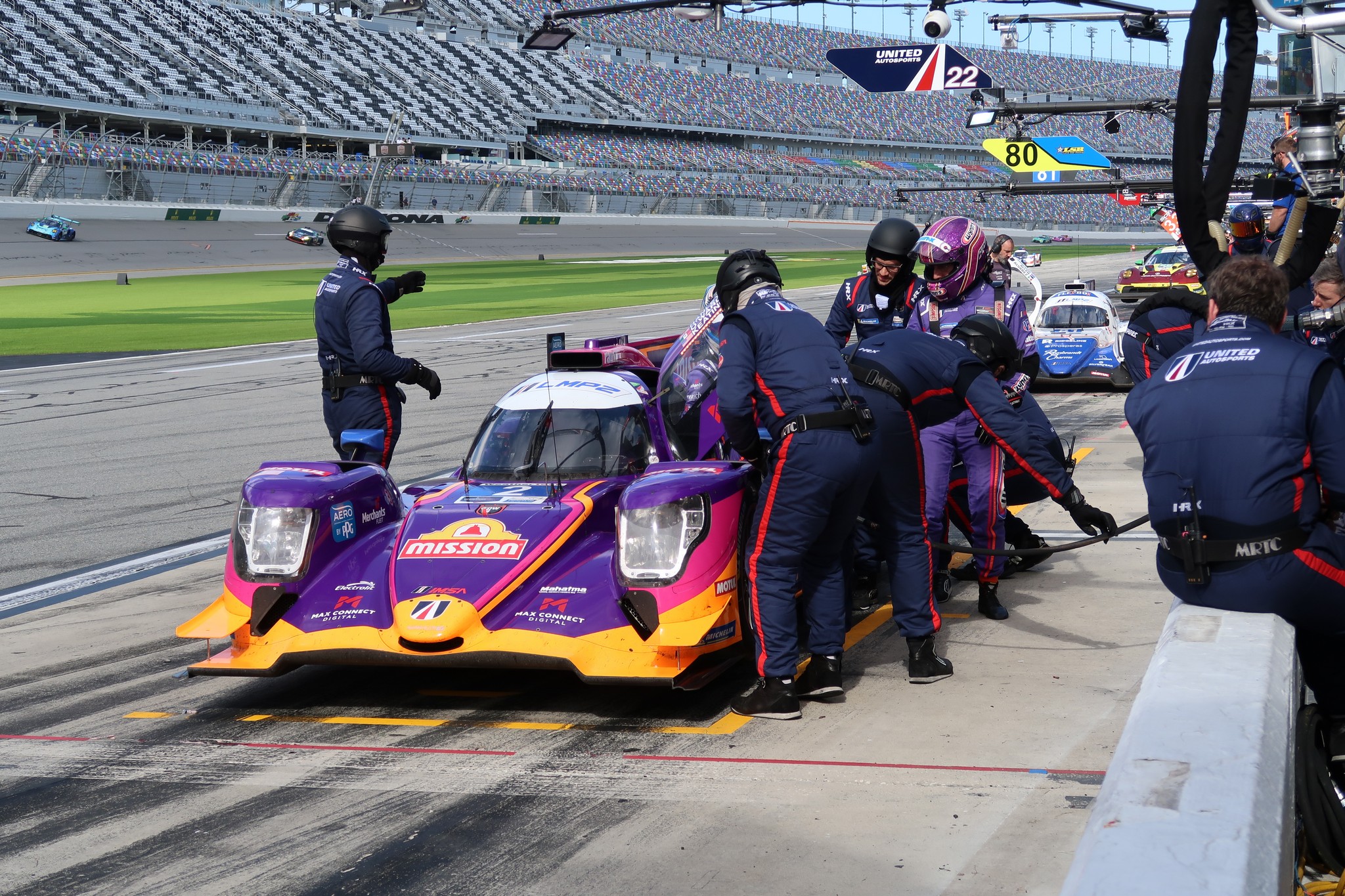
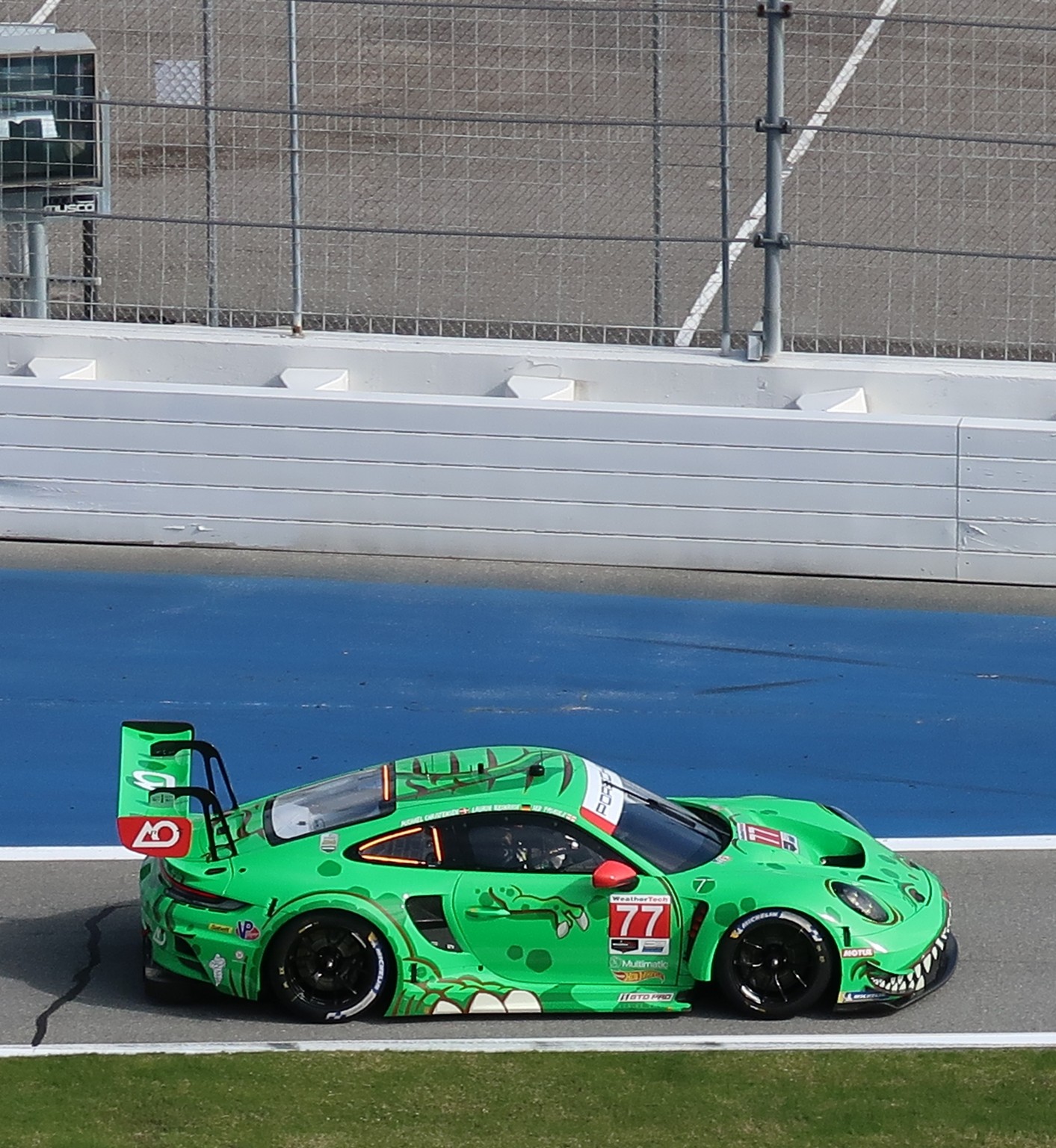
The #5 Proton Mustang Sampling Porsche crashed heavily in qualifying while on a hot lap. Coming around the semi blind kink which is turn 4, he came upon the #85 JDC Miller 963 going slowly trying to warm his tires in the cold temperatures. Rather than hit the #85, he spun himself and crashed into the barriers. A noble thing to do but left his crew with a sizeable repair job. He would start at the back of the GTP field due to lack of a time.
Preamble
Immediately after the Qualifying session, teams started to disassemble the cars and start the race preparation. Some had more to do than others. The Riley / Kelly-Moss Porsche had to swap chassis, as the race one was badly damaged crashing into the barriers between turns 2 and 3 during qualifying.
It was deemed bent, so all the running gear, engine and transmission had to be swapped over. Almost everyone was changing engines and gearboxes. The one exception, none of the Ferrari’s were changing any engines. One mechanic told me the factory said it was not required.
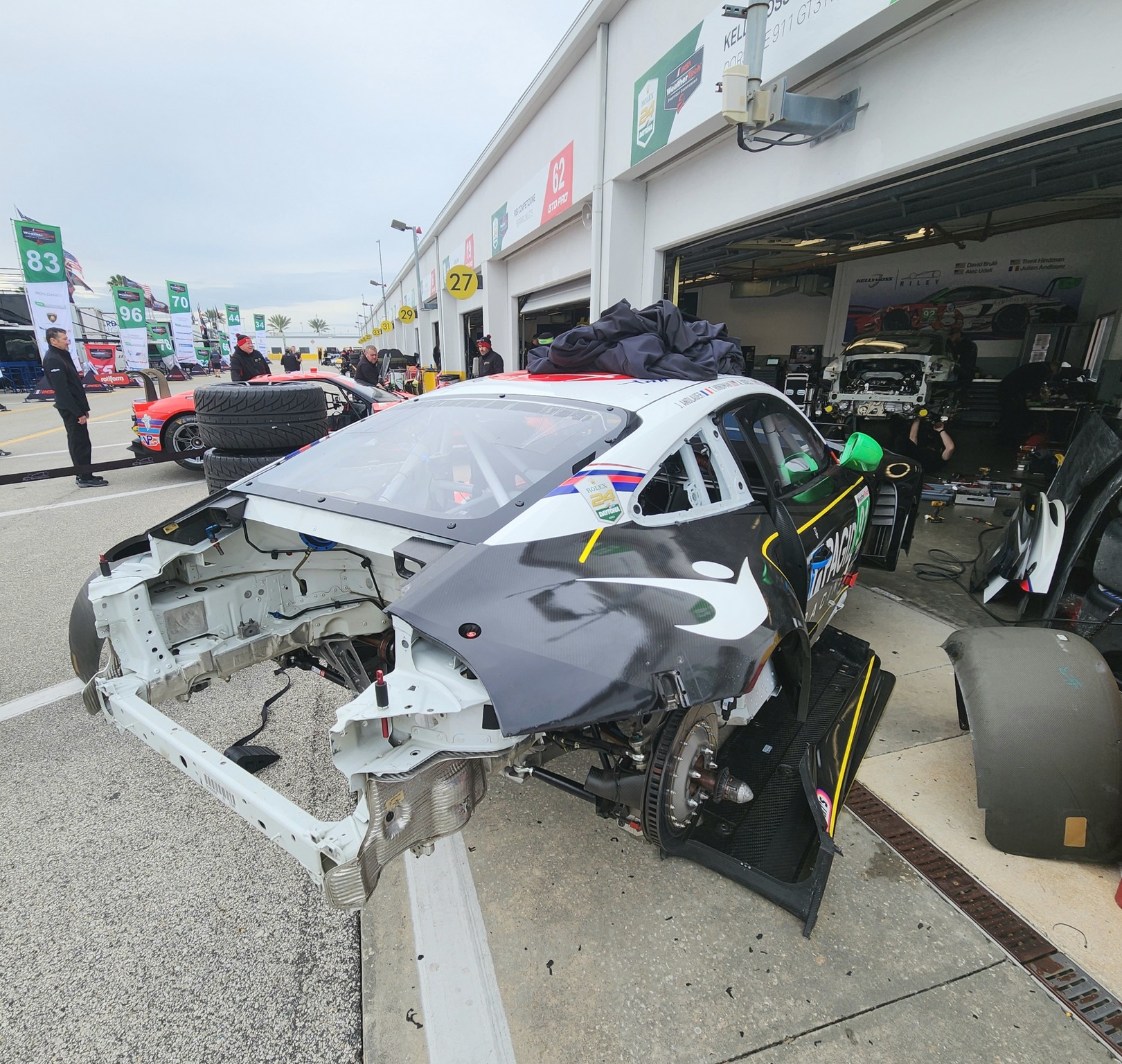
IMSA had taken a novel approach to BOP for GT cars for this event. Multiple meetings with the manufacturers over the past several months resulted in IMSA giving the manufacturers a say in what BOP they needed to reach a target race lap time and top speed. Within the regulations, there is a proviso that allows IMSA to then penalize and potentially send to the garages cars which exceed what is expected. IMSA was kind of in a tough spot as the maximum lap times shown in qualifying, were not going to be duplicated in the race with temperatures some 25 degrees higher and tires having to last up to 2 hours per set in some instances.
Nevertheless, there were a lot of complaints about continued sandbagging. It became clear some could do the “lap time” easily, while others were flat out to do it.
IMSA was not helped by the fact that there were several brand-new cars with very little data to base anything on, namely all the Ford Mustang GT3, the four Corvette GT3 cars (note the Corvettes that ran in 2023 were not GT3 cars, but actually older modified GTLM cars), and the Lamborghinis which were an evo model. It was clear both Ferrari and Porsche had done a fair bit of work to correct all the issues with their 2023 cars. It is interesting to note however, that once a car is homologated by the FIA, changes allowed are very limited for the first year.
The older cars, Acura, Mercedes, Lexus, BMW were well sorted and seemed to have an easier time in preparation and practice, as the teams know the cars very well.
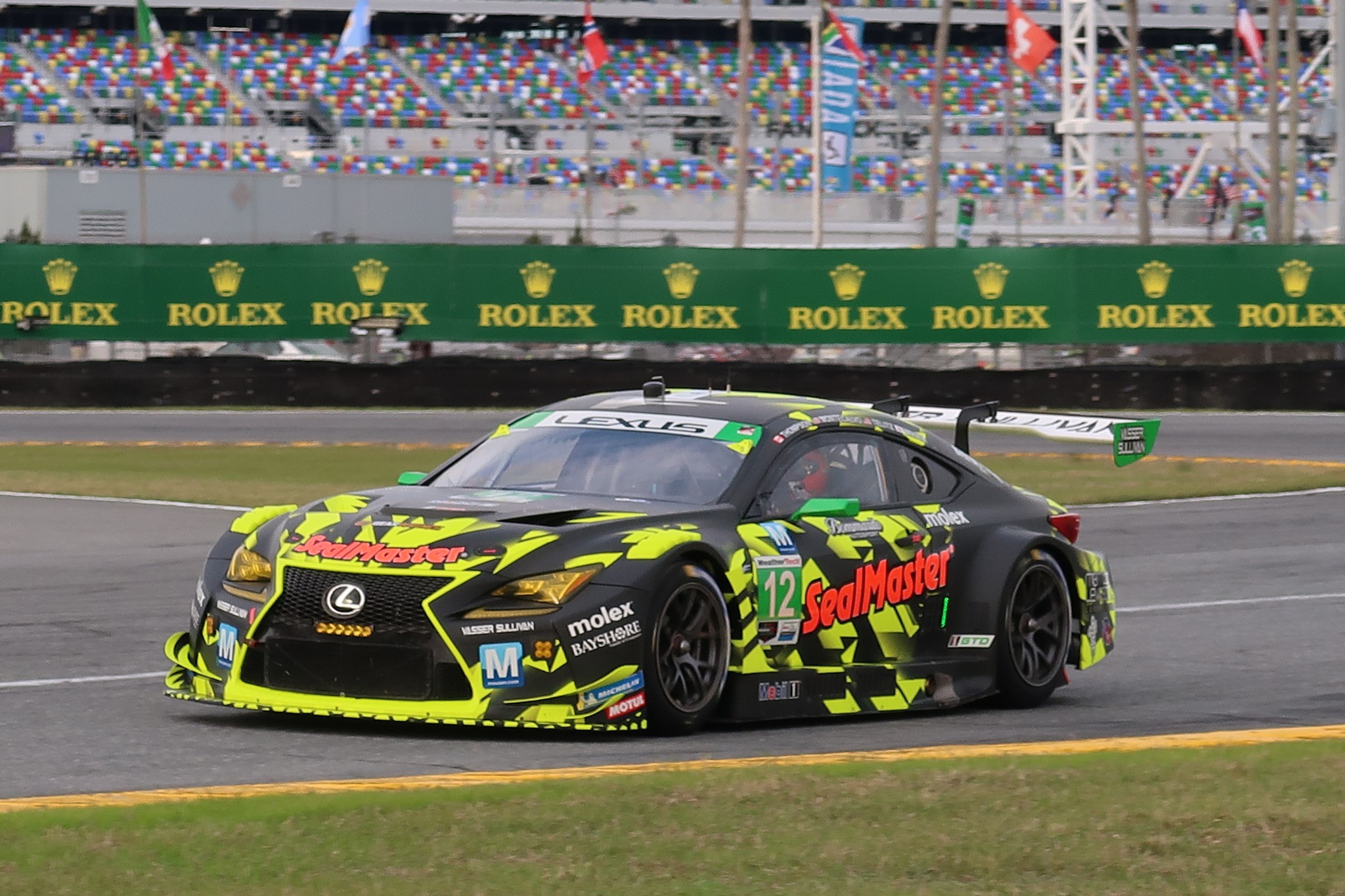
Most of Monday thru Wednesday was taken up with car rebuild and wholesale changes of engines and gearboxes. There were a few practice sessions on Thursday and Friday, including a long night session on Thursday to sort out all the rebuilds and changes.
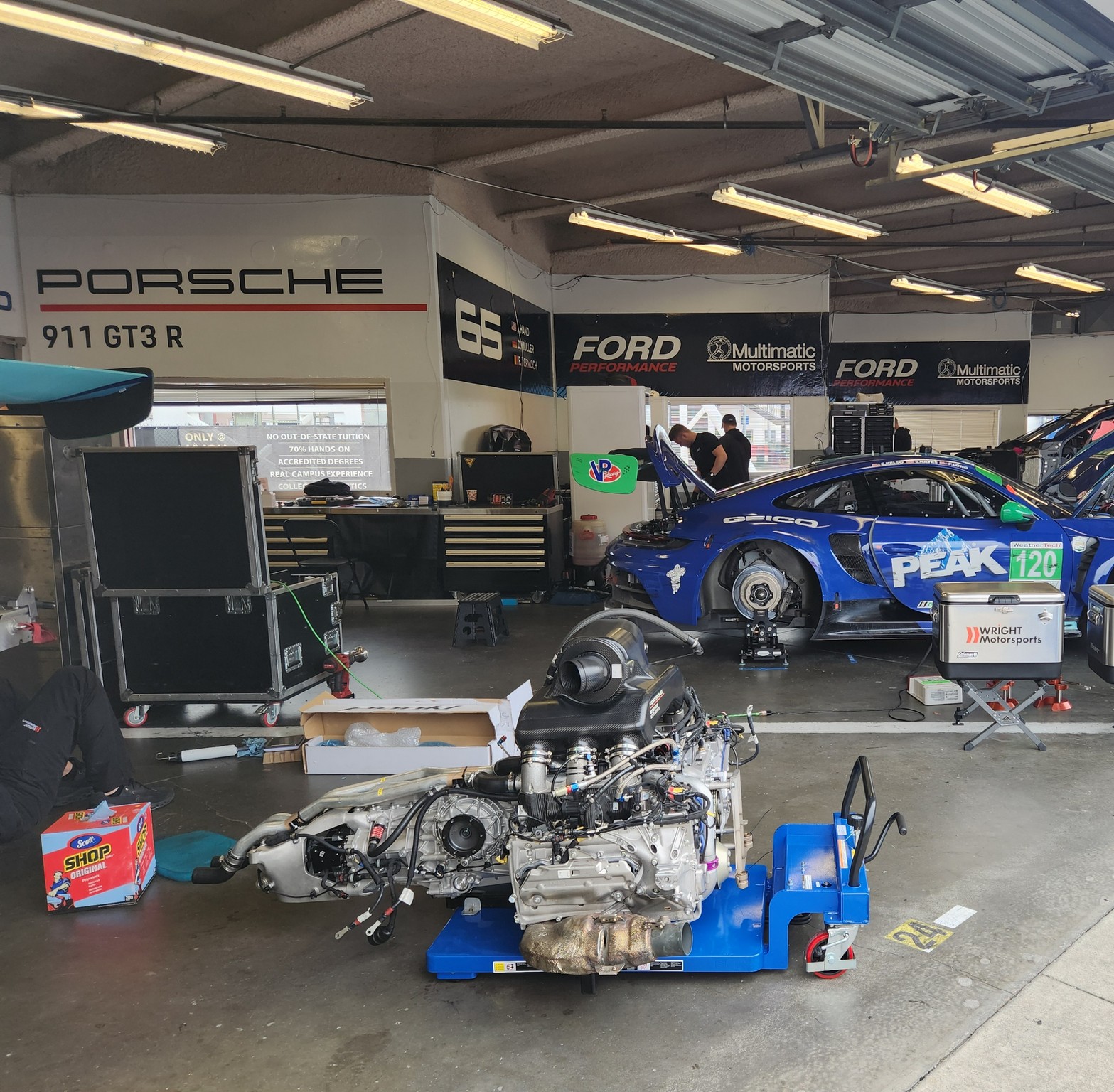
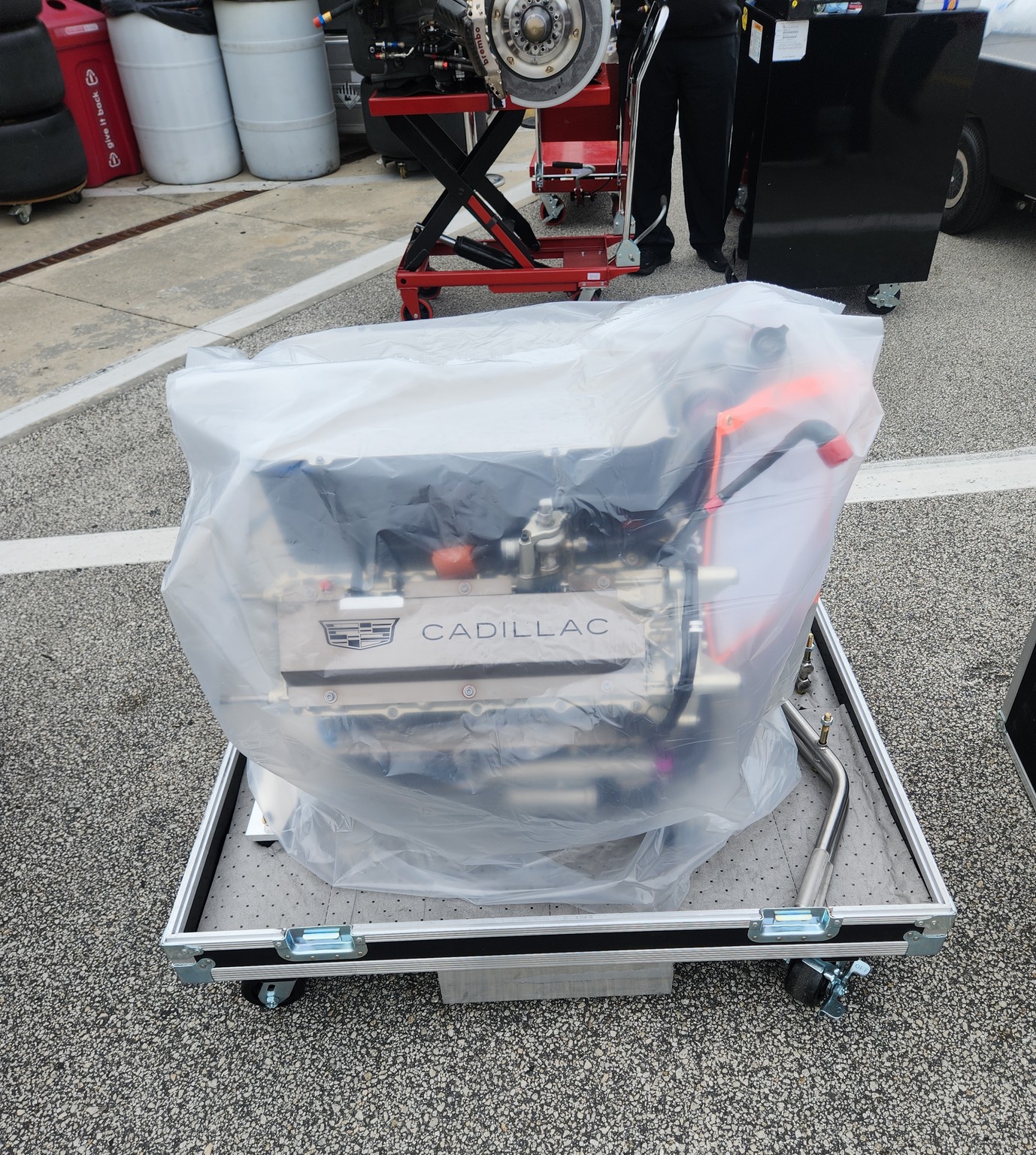
Several teams had more work to do. In the last practice Friday, the Sean Creech entered Ligier LMP2 impacted the barriers and had significant damage which required most of the night to repair. Team owner Lance Willsey seemed to be struggling somewhat with the jump from LMP3 > LMP2.
The two “factory” Corvettes of Pratt and Miller changed engines again on Friday after a reported “urgent message” from Detroit. As one observer remarked, the Engine crane was the most valuable player on the team that week.
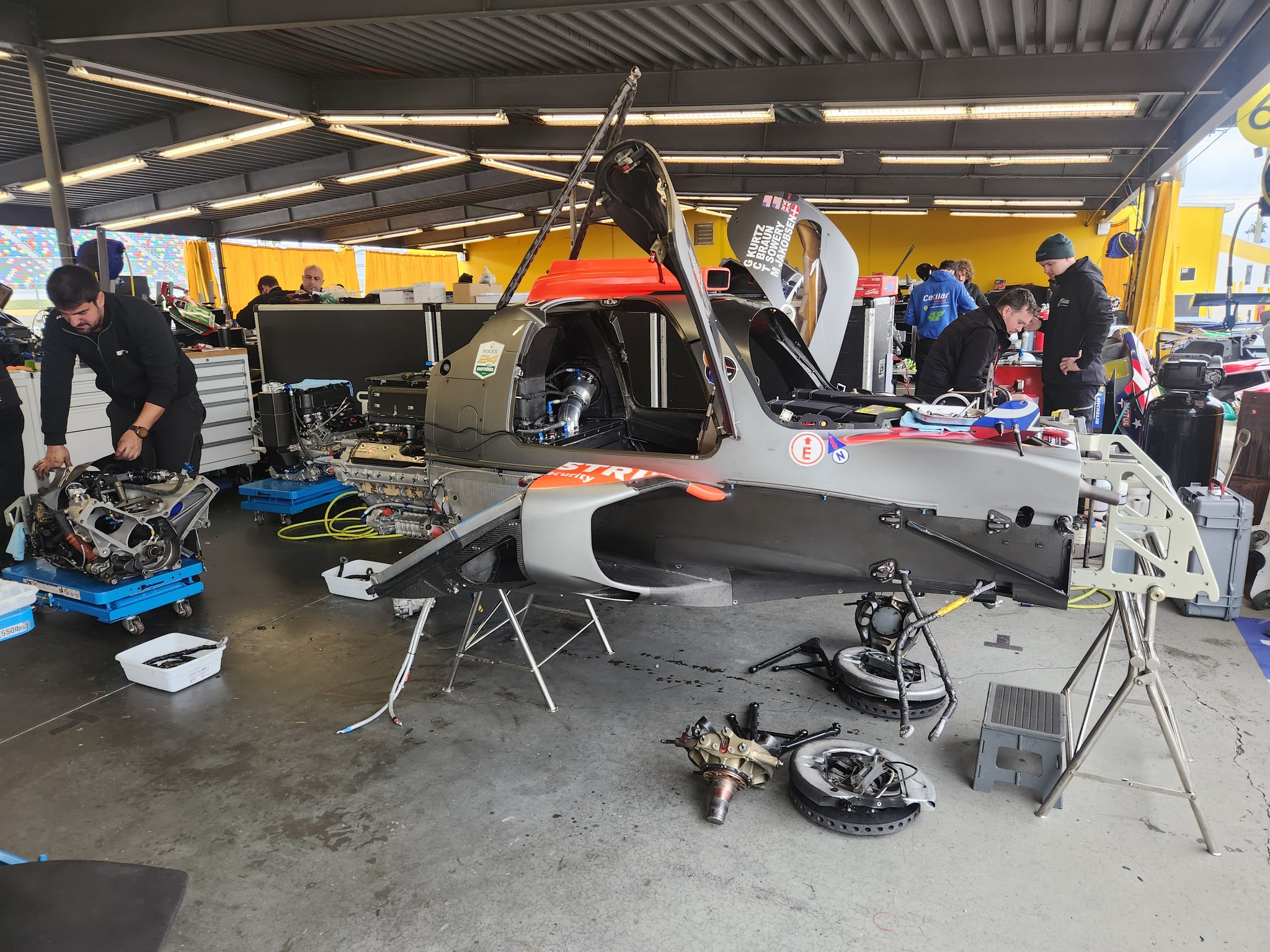
Race Day
Race day dawned much warmer and sunny. A huge crowd was on hand for the start. Every spot in the infield (and camping spots outside NASCAR turn 1) were completely jammed. Some 30 minutes were required to drive in the circuit late morning.
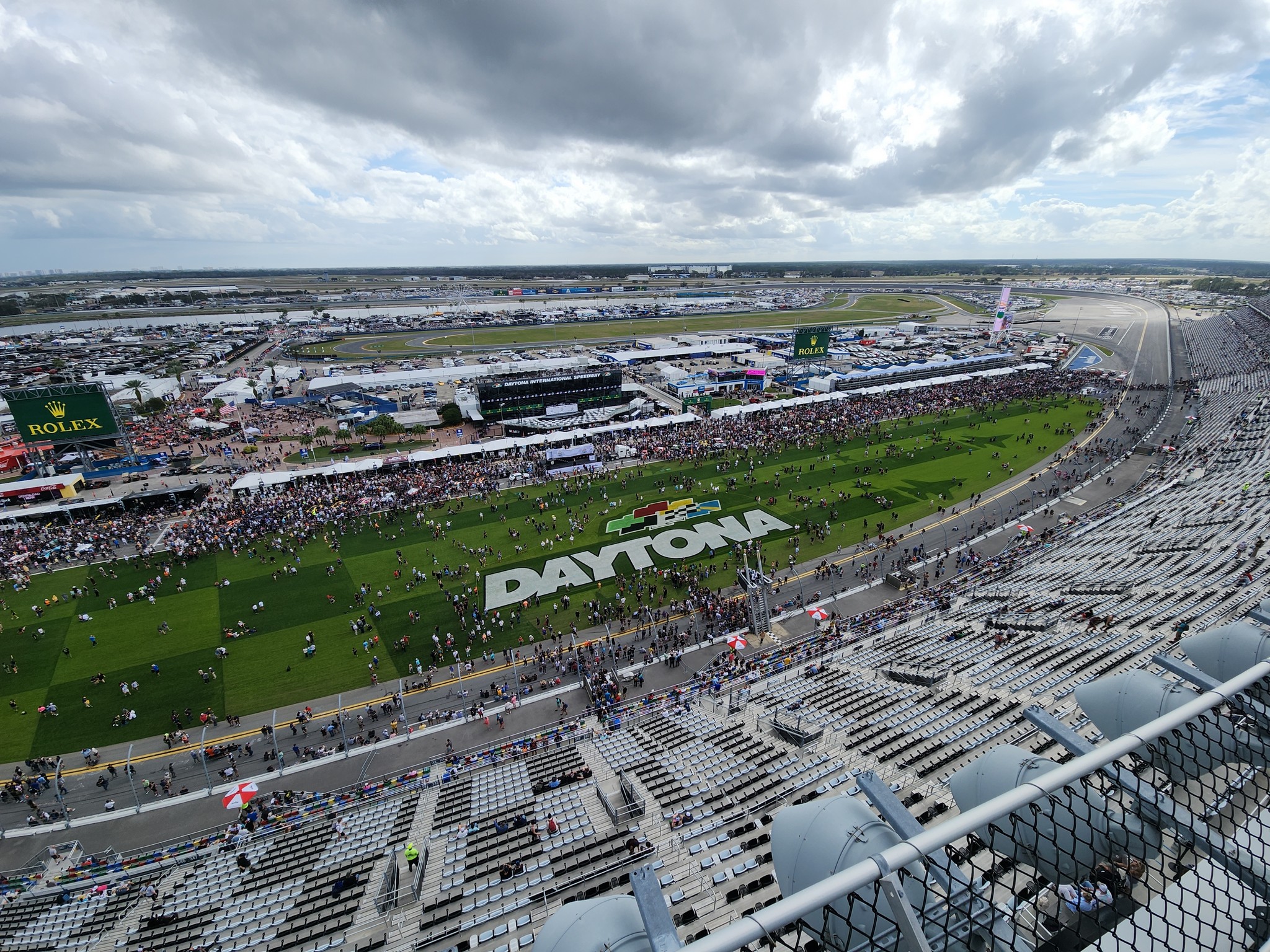
The normal 24-minute vintage car exhibition laps went out just before 9 am. This part of the event is a fan favorite as they get to see some of the old Daytona cars cruise around. This year the list included several Porsche 962s, including the Dauer Le Mans car driven by Danny Sullivan as well as 935s and various GT cars.
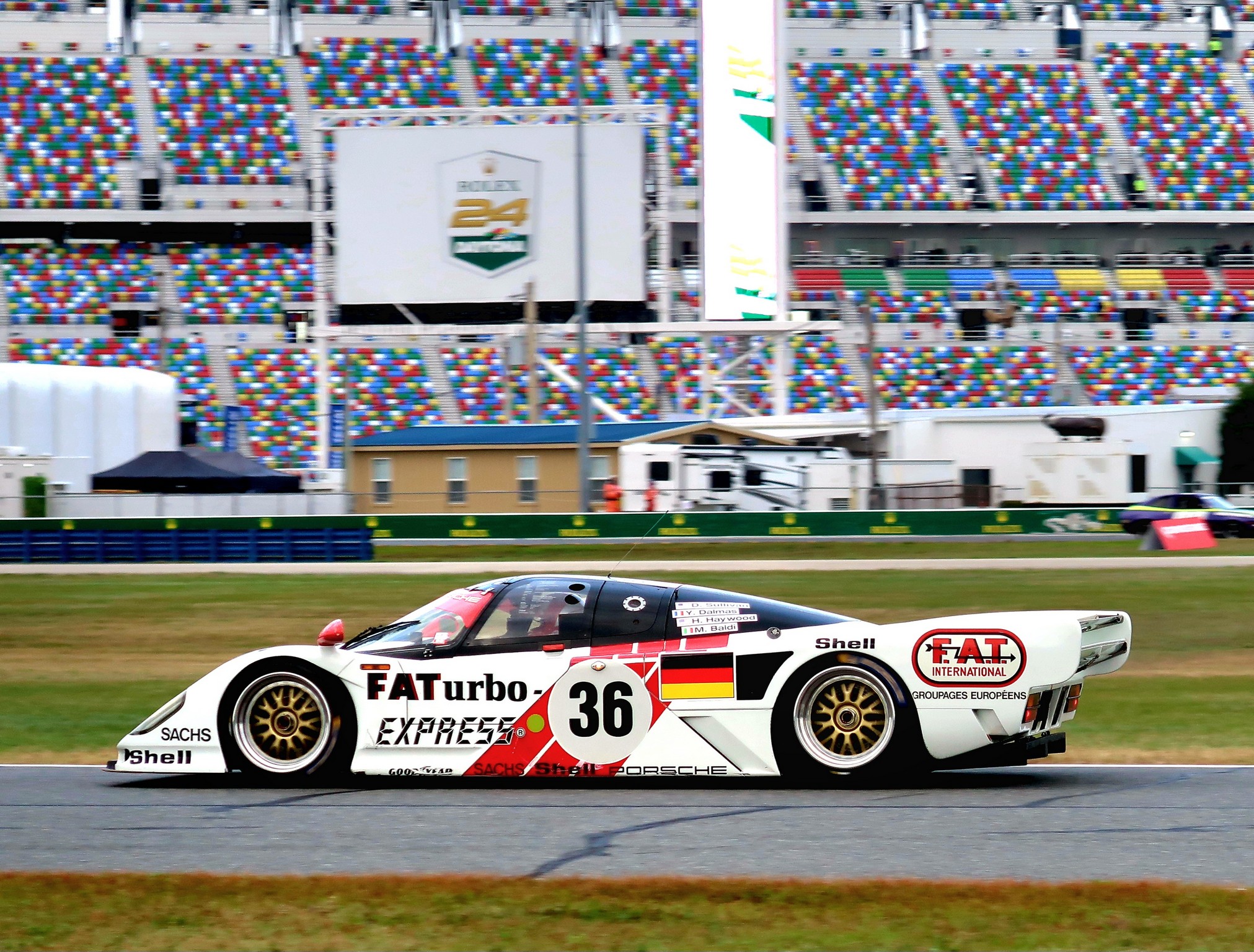
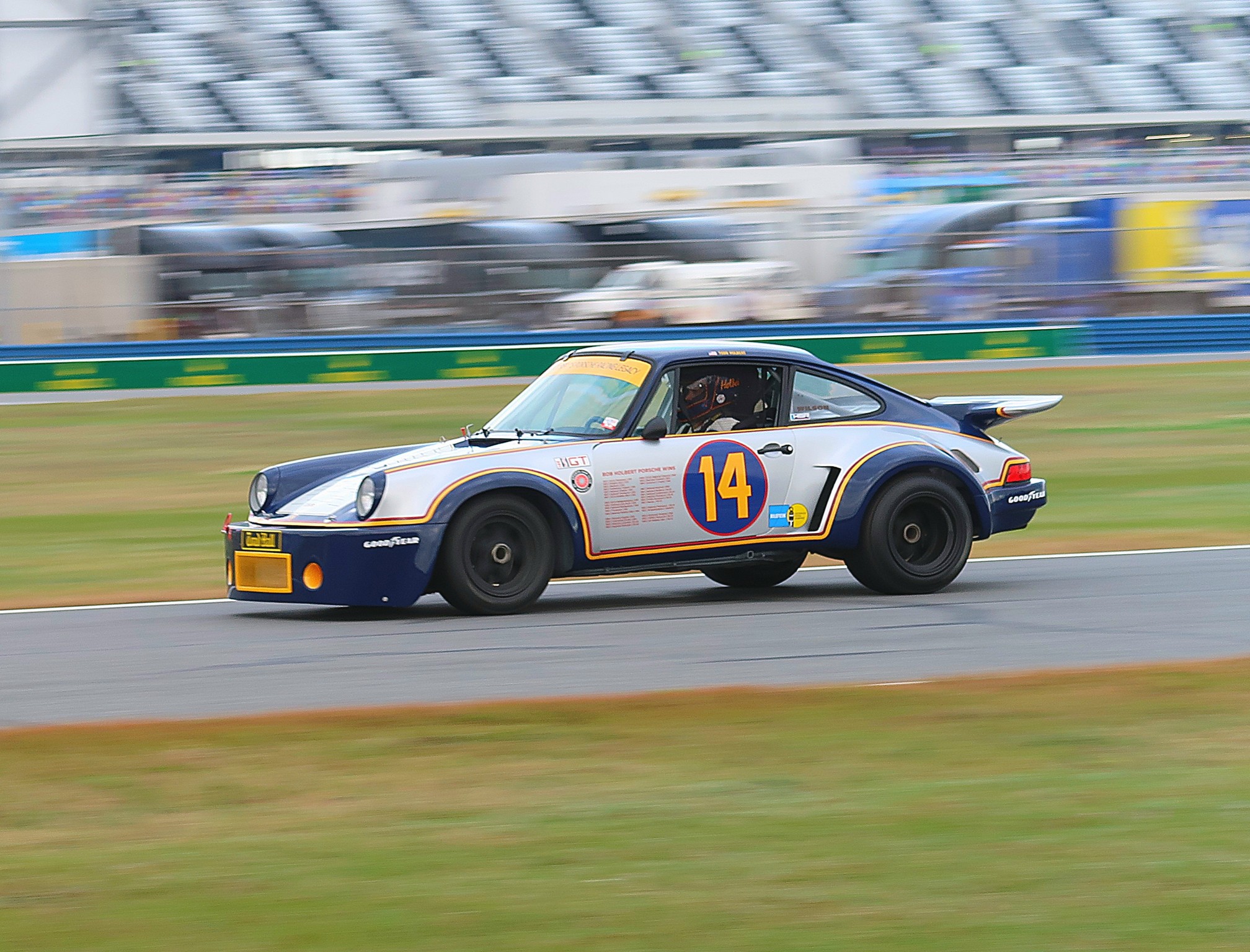
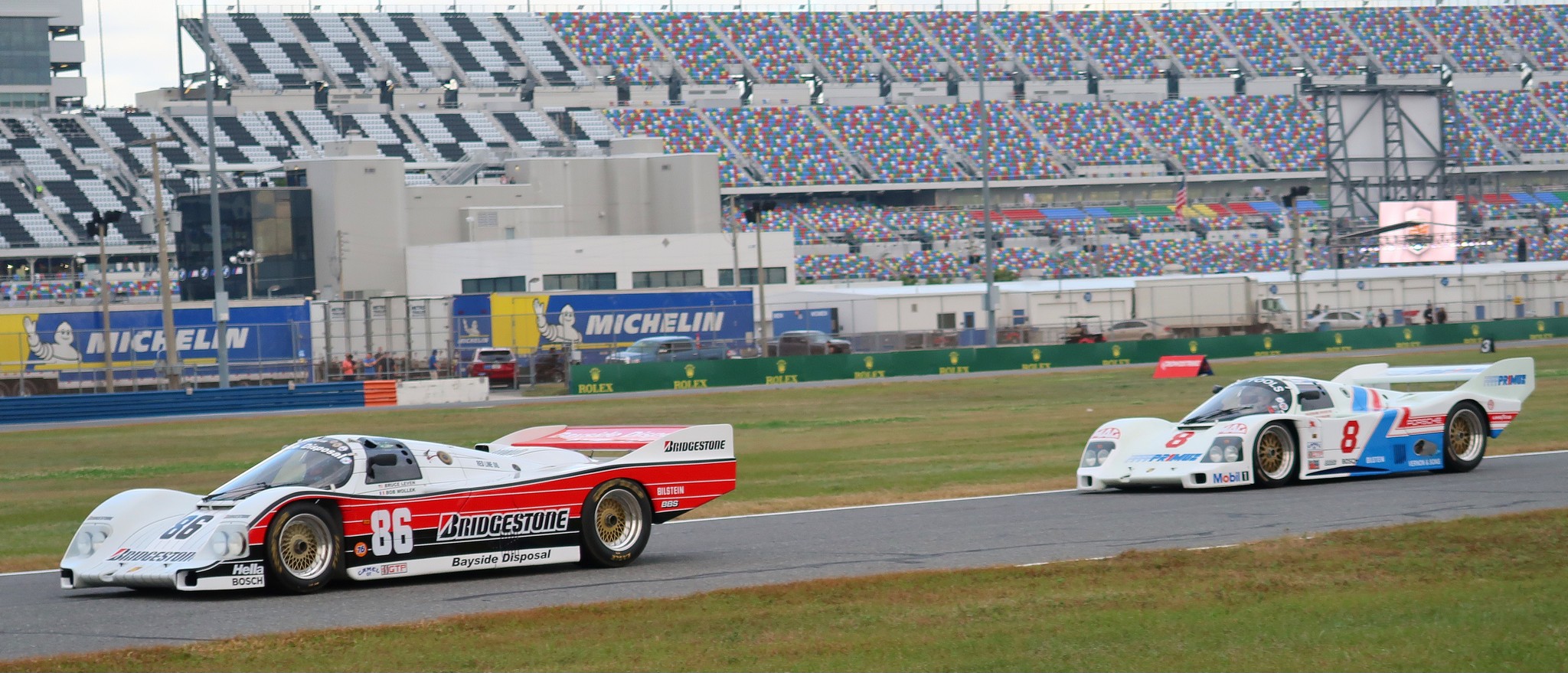
The race started at 1:40pm under sunny skies. The unlucky #13 Corvette would not start, spent the two pace laps getting worked on in the pits and started from pit lane. It would be in and out of the pits and garage many times and eventually finish, but over 400 laps down.
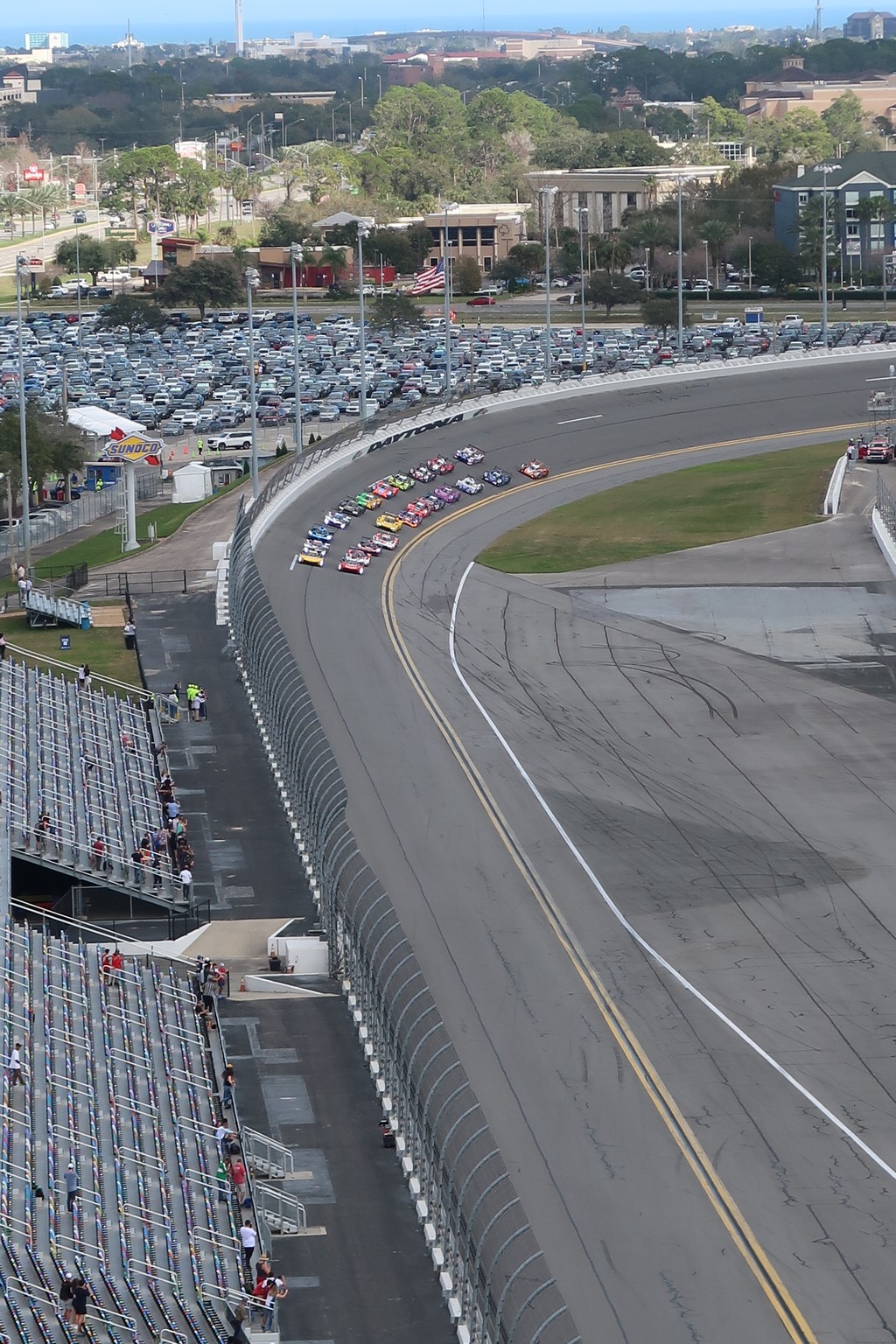
The two Cadillac GTP took the point almost immediately with pole sitter Derani leading the way. The GTP cars lapped in the 1:36 range (after qualifying in the 1:32 range). By the end of the stint the lap times dropped by around 2 seconds a lap.
In GTD the two Lexus and the Risi Ferrari immediately took the front positions and opened a slight gap. The GTD cars were in the expected lap time range, which fell by 3 seconds or so by the end of the fuel stint due to tire degradation.
There were 4 yellow pace car situations in the first 1.5 hours, most of them caused by errant LMP2 cars, either crashing on their own or running into others. One LMP2 crash after about 1 hour exiting turn 1 took out the lead #14 Lexus of Jack Hawksworth. The #14 spent many laps in the garage for repairs and fell out of contention.
Early pit work was shoddy, as everyone must have forgotten what to do since Petite LeMans 2023. Numerous speeding penalties, too many men over the wall, unmanned fire bottles during refueling. One car drove off with the fueler still attached to the car. Several cars ran the red light at the pit out. Quite a few were flagged for illegal pass arounds during pace car laps.
By 7 pm darkness had fallen, and things seemed to settle down somewhat. The Cadillacs still looked the strongest, although after 8 hours of racing, the top 9 were separated by 24 seconds. Positions changed depending on pit stops, and the age of the tires on the car.
Shortly after the 8-hour mark reliability issues started to happen for cars which historically did not have any. The #10 Acura of Wayne Taylor/ Andretti stopped in turn 3 with shifting issues and reported burning smell. The #01 Ganassi Cadillac had a flat tire and got caught speeding in the pits losing 2 laps in the process.
The #6 Penske Porsche was penalized at least once for exceeding the mandated power output, which required a pit stop to make appropriate changes via a software change to the ECU. Subsequently it was reported, Porsche performed the same software update on the #7, #5 and #85 963 cars.
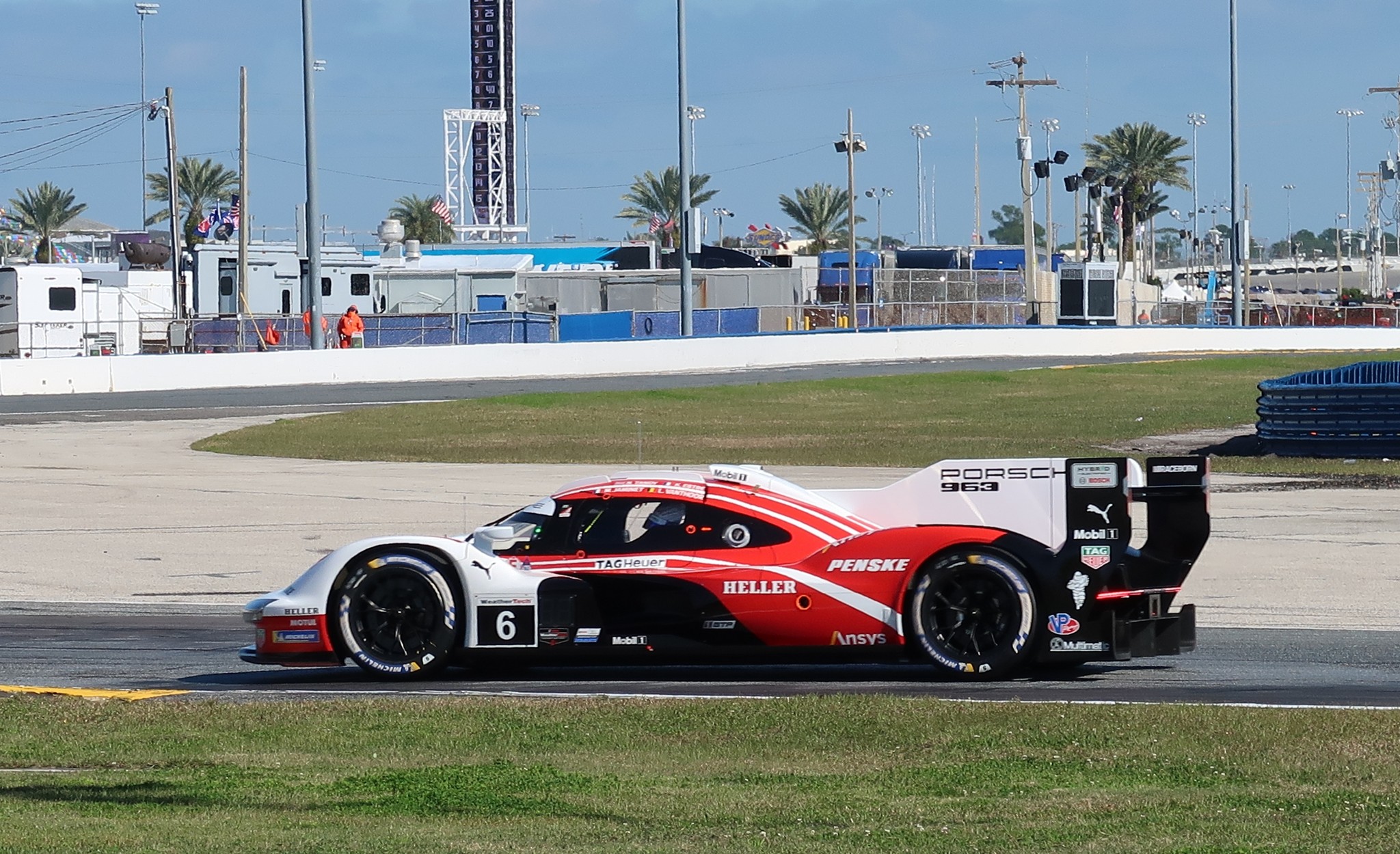
By the halfway point more kinks started to appear for various cars. The #40 Acura GTP shut itself off in turn 6 and lost several laps getting restarted. Both Corvettes of Pratt and Miller had problems, one with a gearbox oil leak, and the other with reported brake issues. The Multimatic Mustangs had issues with the rear diffuser and bodywork and lost time. It wasn’t clear if this was just falling off or due to on track contact.
Through this all, the #31 Cadillac continued to lead. Pipo Derani twice did Quadruple stints in the night. We found out later they were trying to save Blomquist for the finish. The Porsche 963’s and the two BMW’s continued to maintain contact with the #31 Cadillac.
After 15 hours, at 4:40 am, more things started to go wrong. The #01 Cadillac was out, with an engine problem. The two BMW’s lost multiple laps, one due to a gearbox oil leak, and the other due to a faulty steering wheel which shorted out the electrics and shut the car off. The Corvettes pushed hard to keep up with the Risi Ferrari, but soon started falling back with their maladies, which got worse.
Both went back to the garage for repair but continued. The #70 Pfaff McLaren which had been running strongly went to the garage for an extended period with electrical problems. The #32 Korthoff Mercedes got a penalty while running 2nd in GTD for using underinflated tires. This called for an immediate stop to replace tires, losing 2nd place.
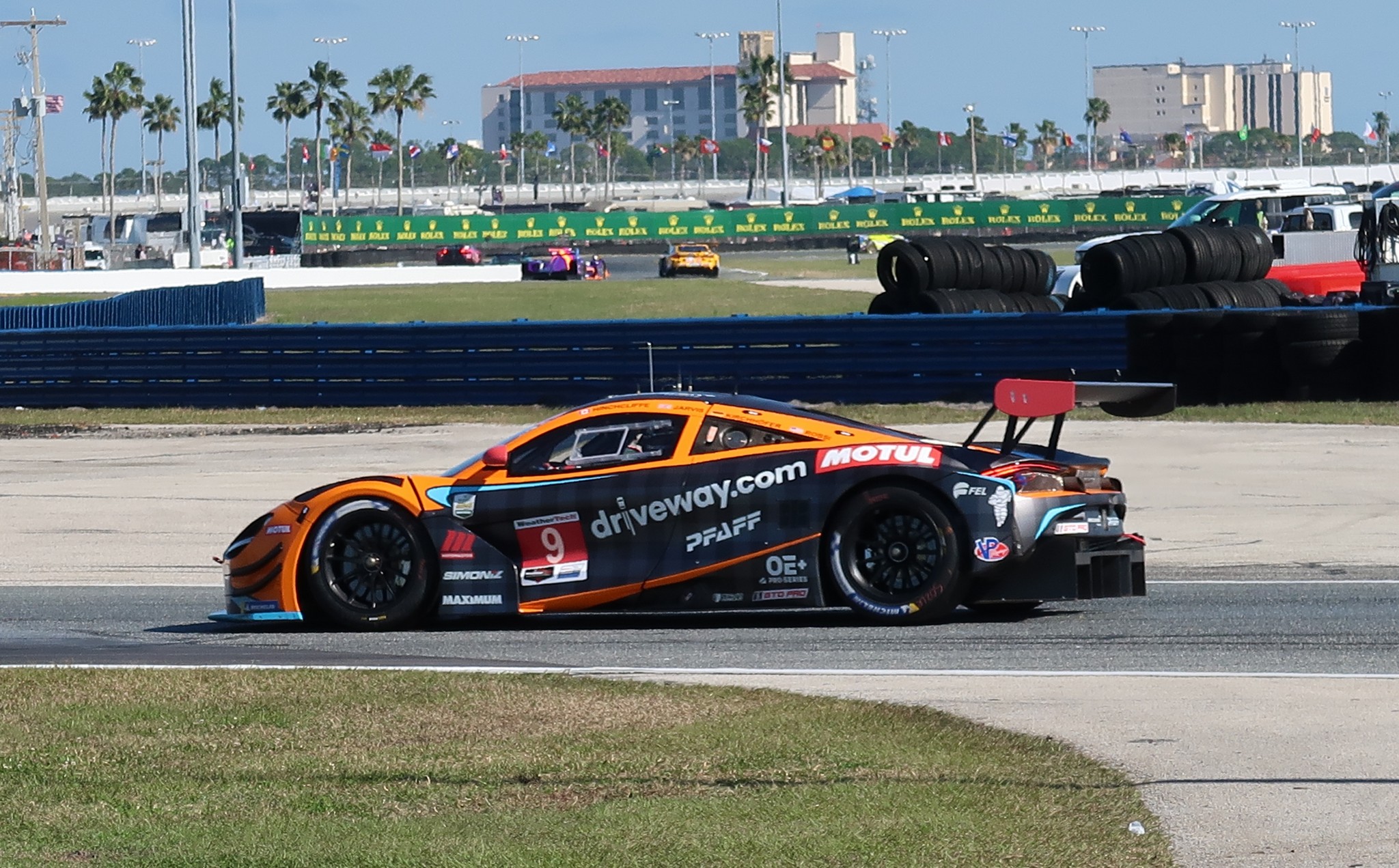
By 8:40 am at 19 hours distance, the top 5 were still in contact on the same lap, the four 963 Porsches now showing some more speed than they had during in the night. As of 8:00 am, by rule the GTP cars had to switch back to the harder of the two tires, which may have impacted lap times slightly.
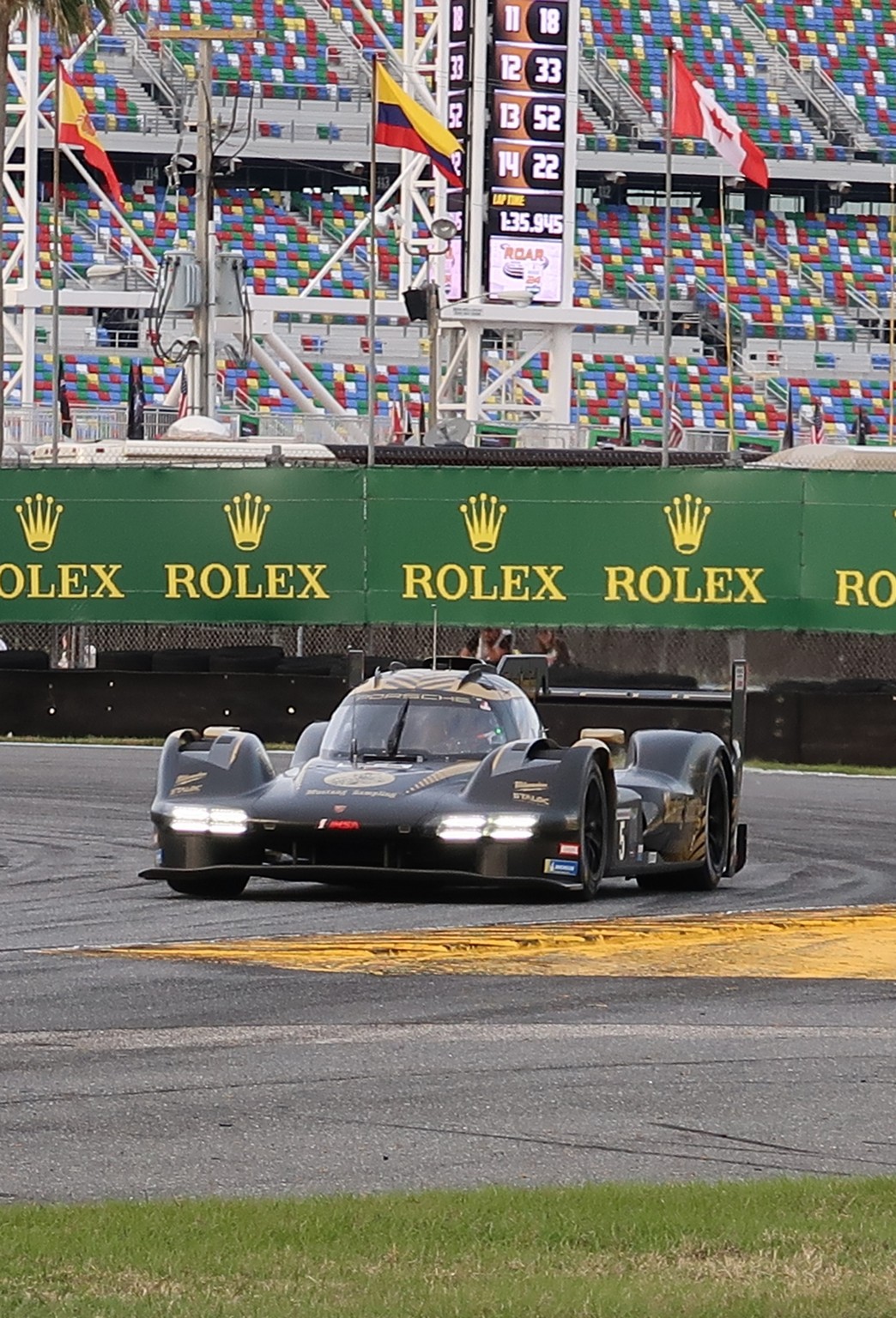
In LMP2 there were still about 5 cars in the hunt and were running close to each other on the same lap. Several had crashed out or gone to the garages for extended repairs and were well behind. The normally reliable class had turned into a survival battle due to self-inflicted mishaps.
The top cars in GTD Pro were the Paul Miller BMW, the Risi Ferrari, Corvette #4 which had recovered from their electrical issues and the #77 AO Racing Porsche, which had run a steady pace and was back in the hunt.
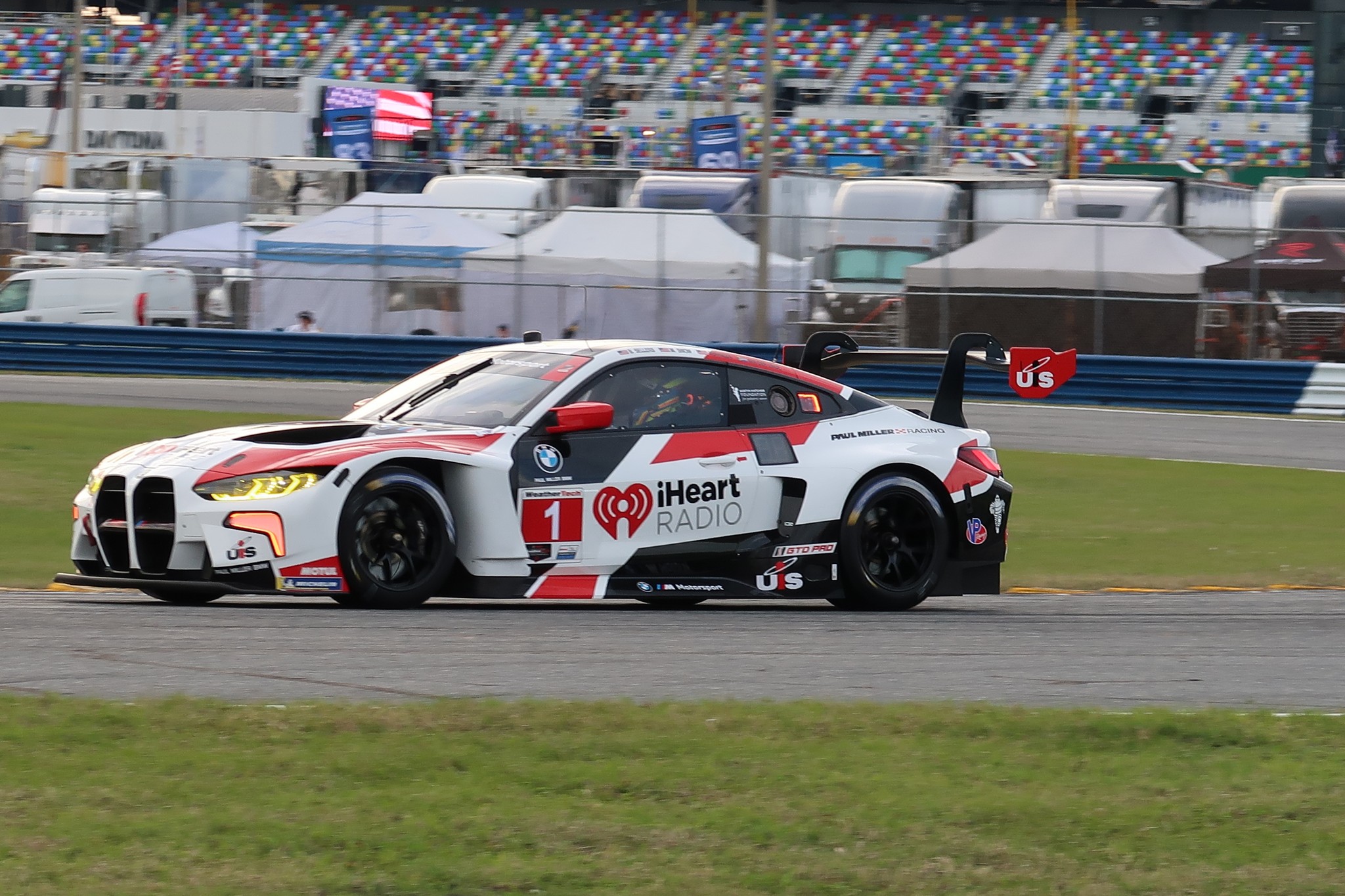
In GTD it was coming down to a battle between Mercedes and Ferrari, the rest having had some sort of issues and falling back.
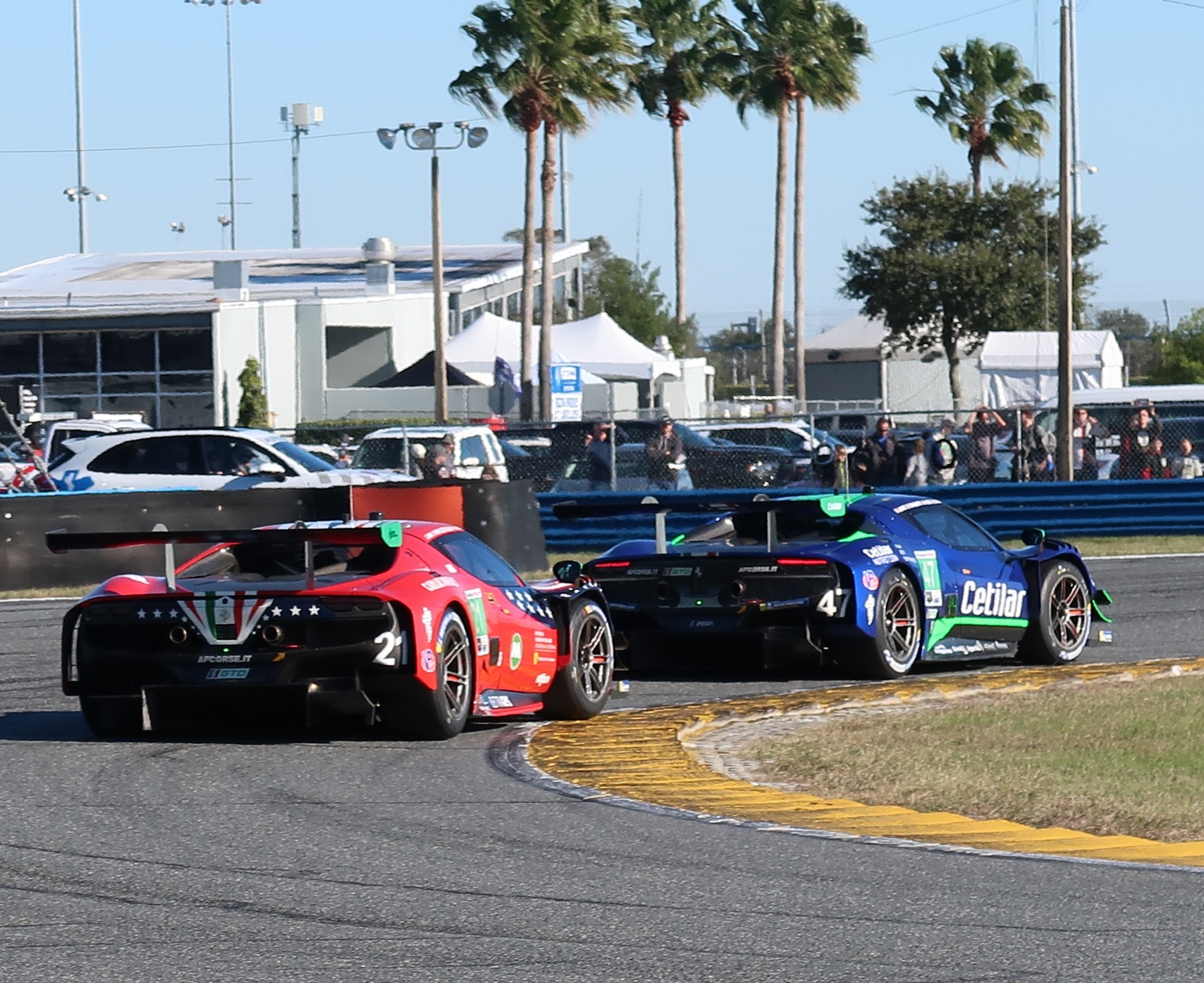
With about 45 minutes to go, the Lexus #12 driven by Aaron Telitz had clawed it’s way back to running with the top group in GTD. As it left the pits, it burst into flames and temporarily blocked the pit exit lane. The resulting yellow with pace car allowed everyone to pit and probably get to the finish. However, the GTP cars would be at their limit depending on energy consumption.
Blomquist and Nasr in the Penske Porsche came in together, but the Penske crew was able to get him out just feet ahead of the Cadillac. For the last 35 minutes they ran within 1 second, Nasr in front. The Porsche was slightly quicker on the straights, and the Cadillac would close up under braking and the corners but was never quite close enough to attempt a pass.
There was some turmoil at the end, as due to an officiating error, the white flag was not shown to the two leaders, and the checker was shown at 23 hours 58 minutes 25 seconds. But by rule it is irrelevant as once the checker is shown, the race is over. Most of the other classes got the white and in fact time had expired on the 24 hours by the time they made it thru the last lap, so no results were really affected.
Final Takeaways
Penske had won his first Daytona 24 hour in 55 years, the last one being in 1969 with a Lola T70 driven by the great Mark Donohue and Chuck Parsons. The Porsche 963 proved very reliable finishing 1st, 4th, 5th and 6th . Blomquist finished 2.1 seconds behind. Both teams did an excellent job, and it was almost sad that one of them had to lose. The GTP cars are very close in terms of speed, and all indications are the racing this year will be as close as it was in 2023.
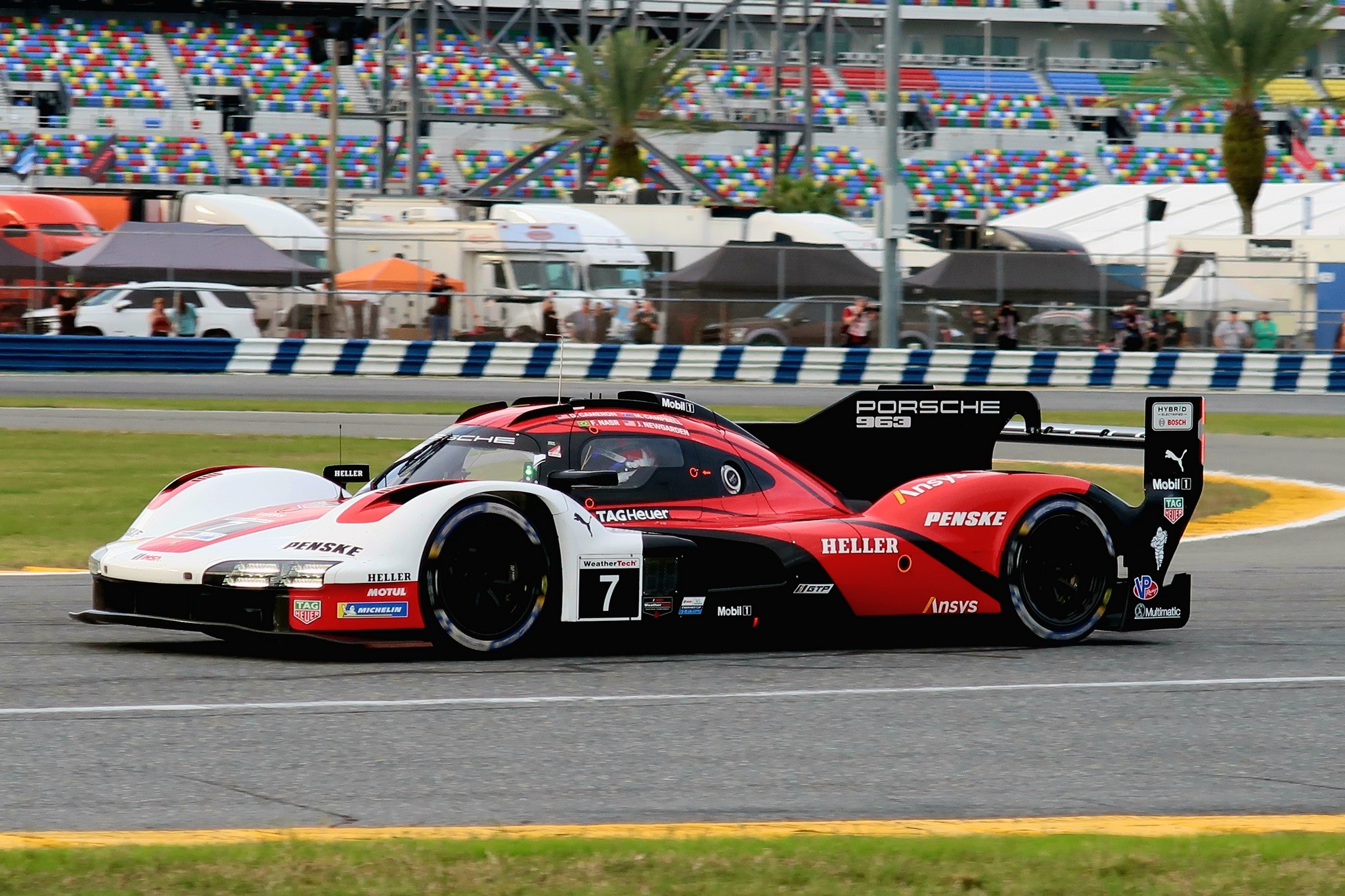
The normally very reliable LMP2 cars were reduced to only 5 cars (of the original 13) finishing on the lead lap. Race winners were the #18 ERA Motorsports car of Merriman, Dalziel, Zilisch, and Rasmussen. Zilisch at age 17 will undoubtably be the only one in his high school class with a $20,000 Rolex watch !
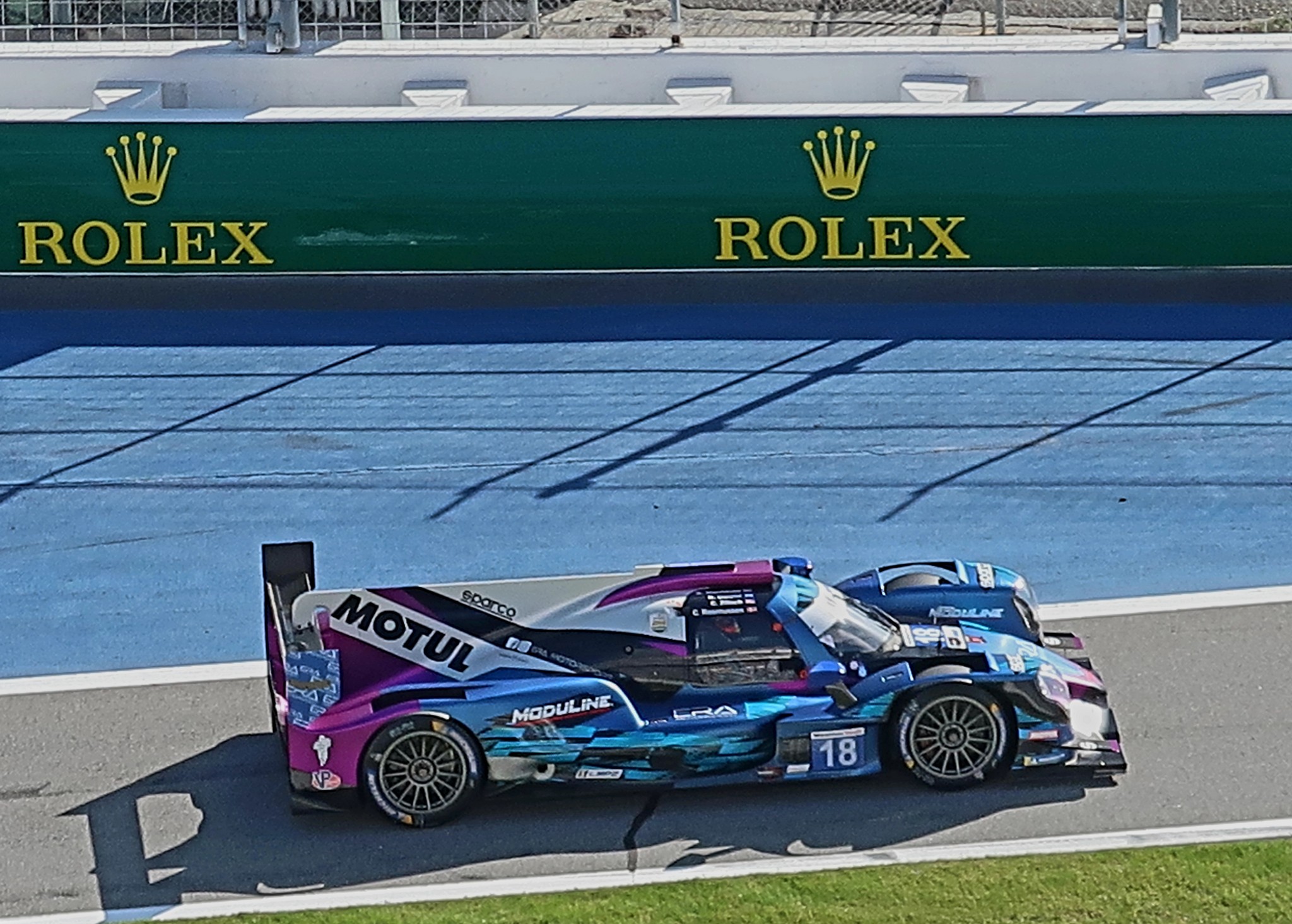
In the GTD classes Ferrari did a good job improving on their disastrous showing in 2023 where only 1 car even finished. In 2024, all five finished with Risi winning GTD Pro over the AO Racing Porsche and the Paul Miller BMW. In GTD the Ferraris finished 2nd, 3rd, 4th and 10th, behind the winning Windward Racing Mercedes of Ward, Ellis, Dontje and Morad, who was the finisher.
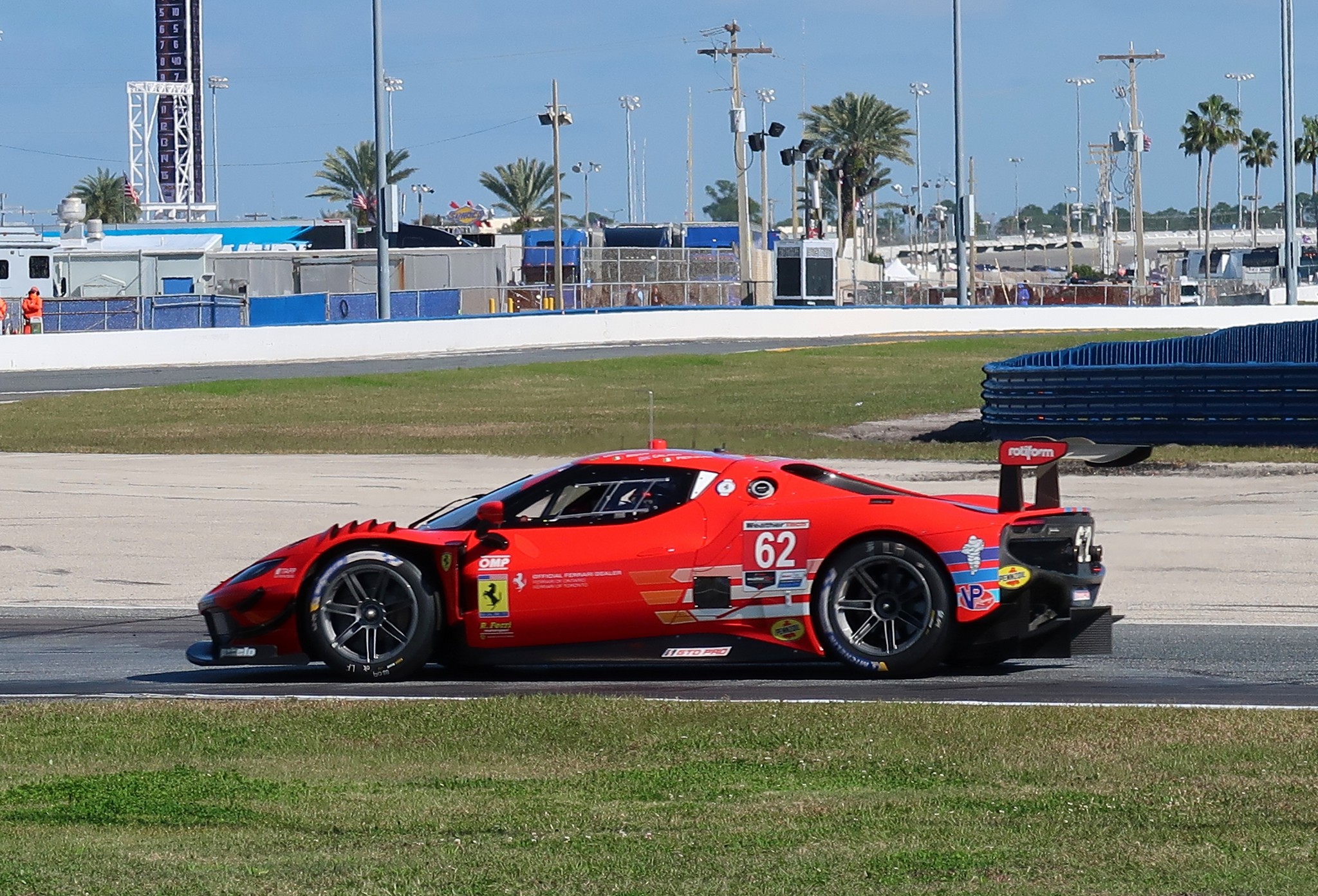
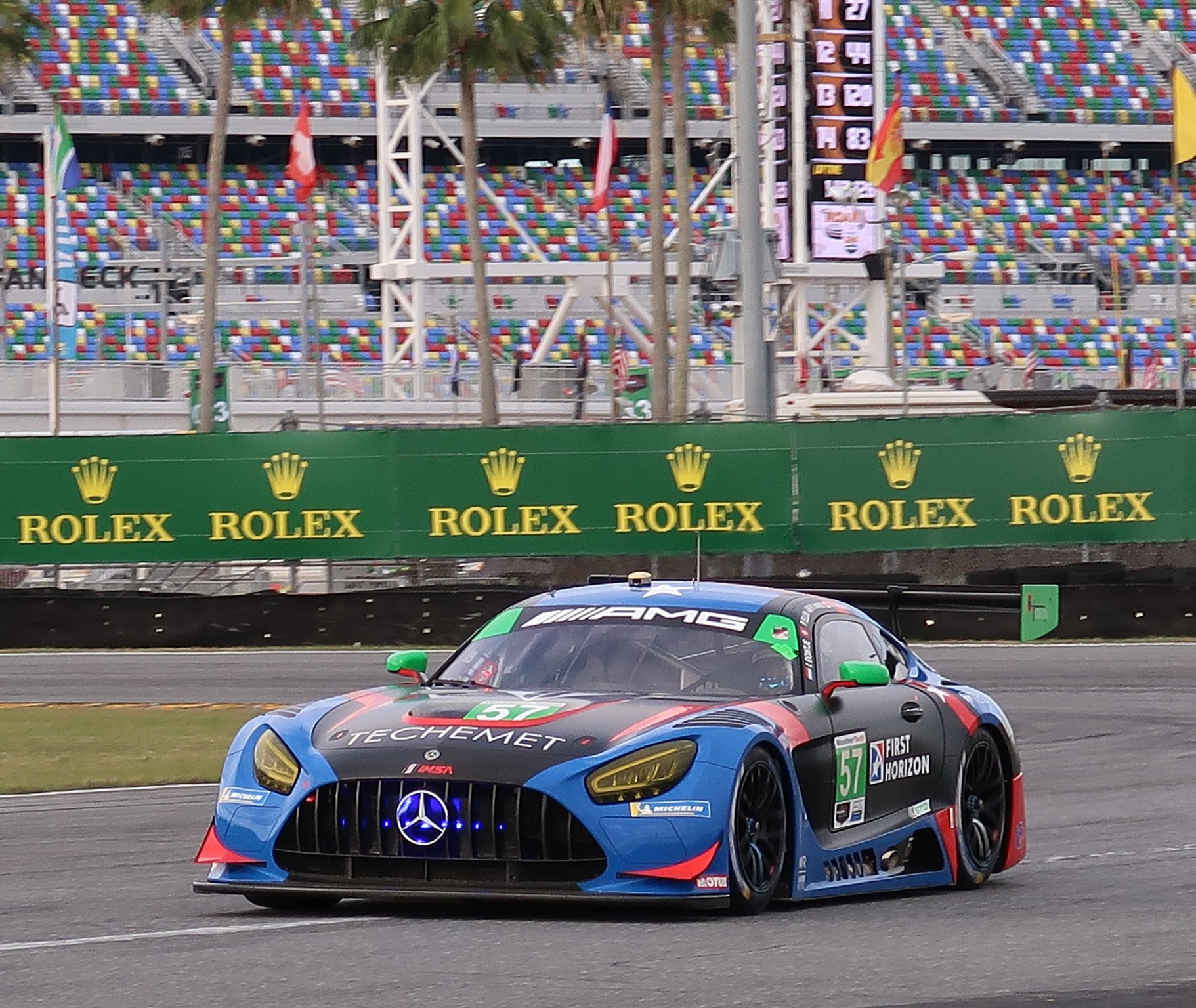
Proving the adage that it is hard to start and win a 24-hour race with a brand-new car. The well sorted cars with 1 plus years under their belts did better than the new cars from Ford and Corvette. That will change as time goes on.
What was clear, it was a great event with a record crowd. The racing was close and exciting. Another classic comes next in less than 2 months’ time, Sebring.
Additional Photos From 2024 Daytona 24 Hours
